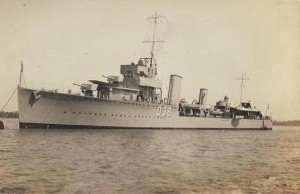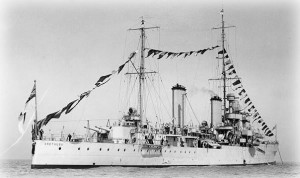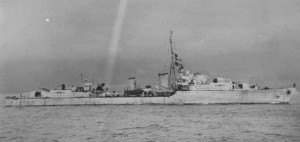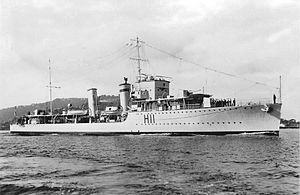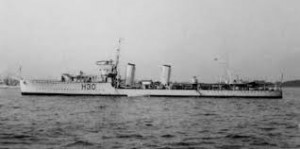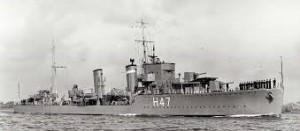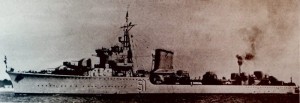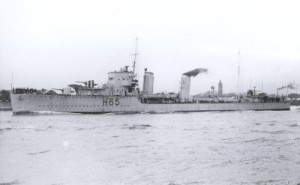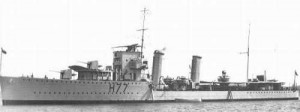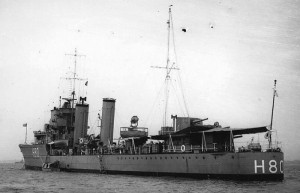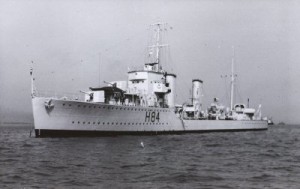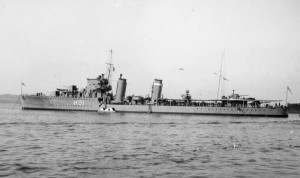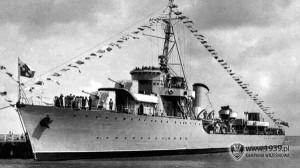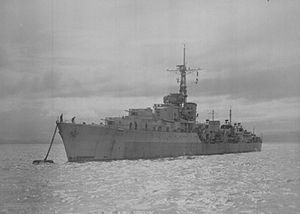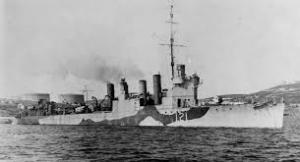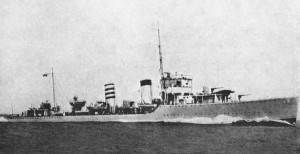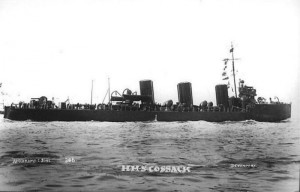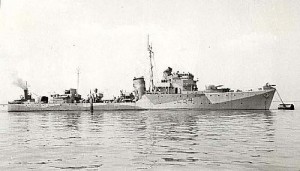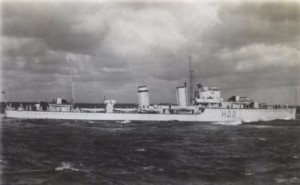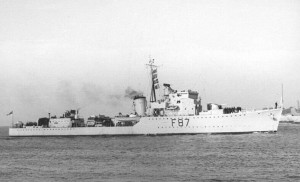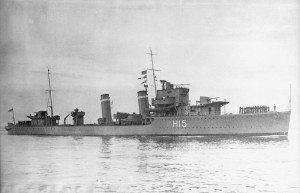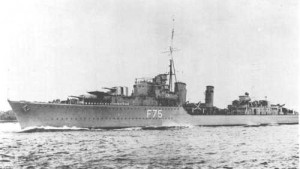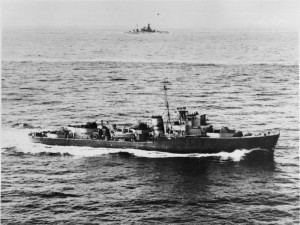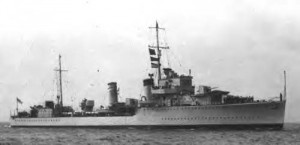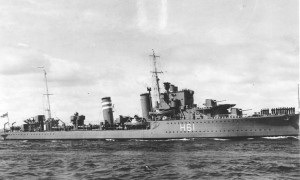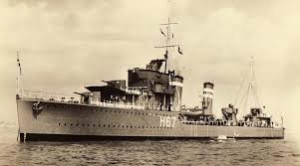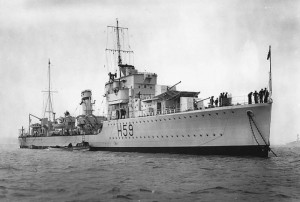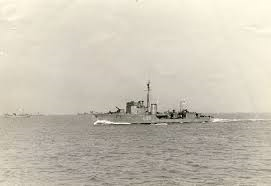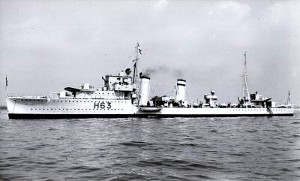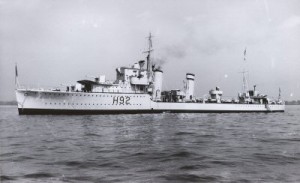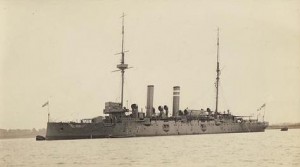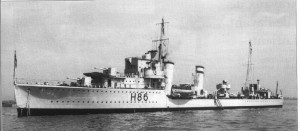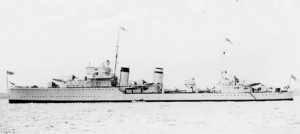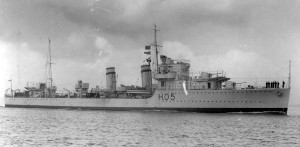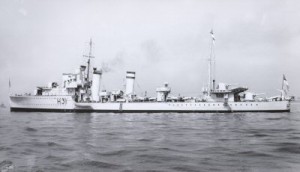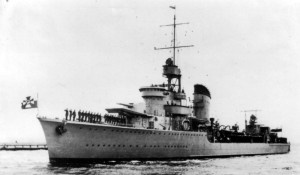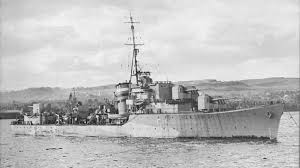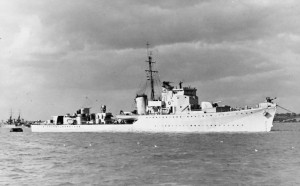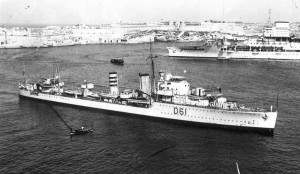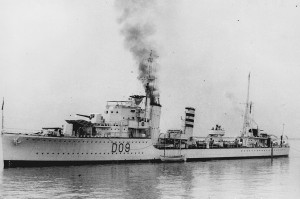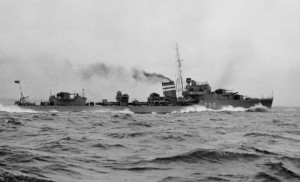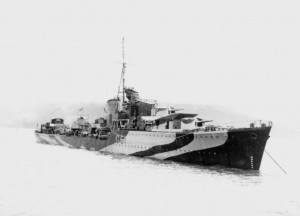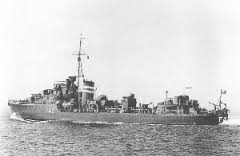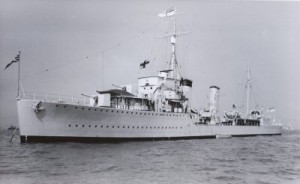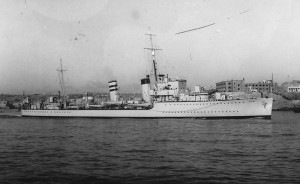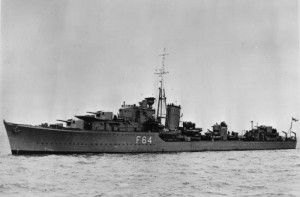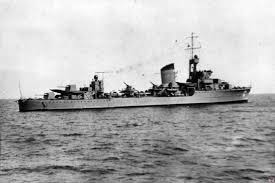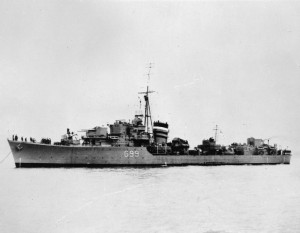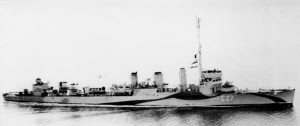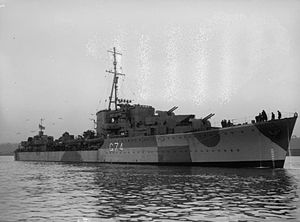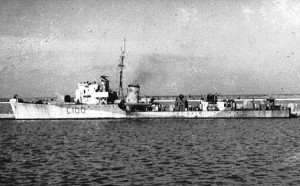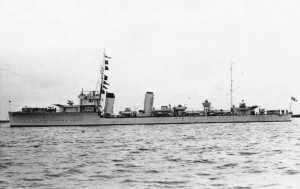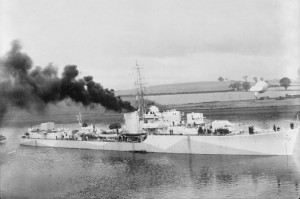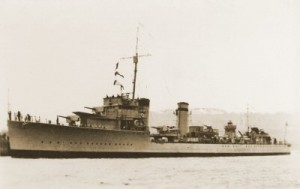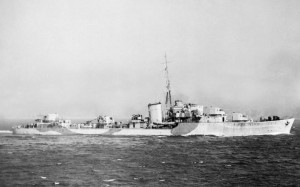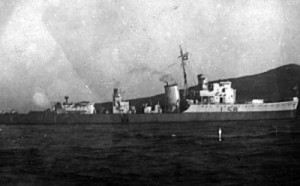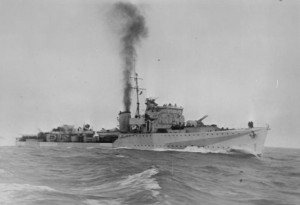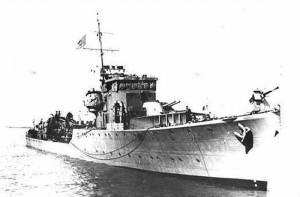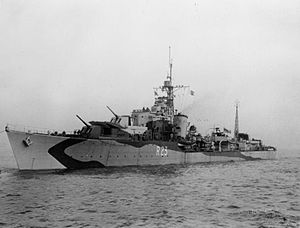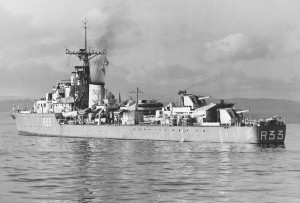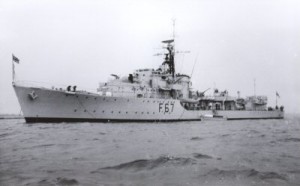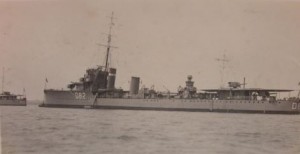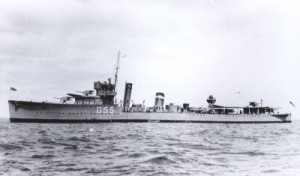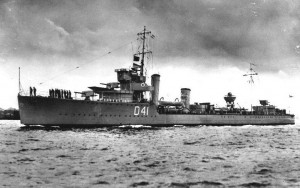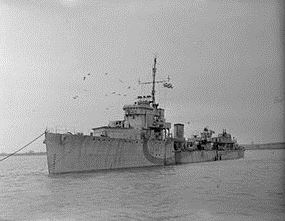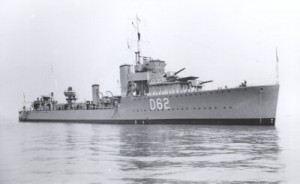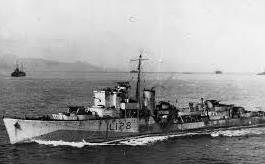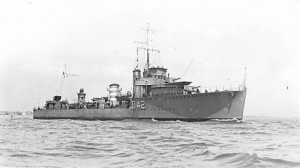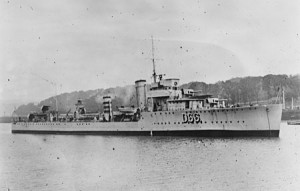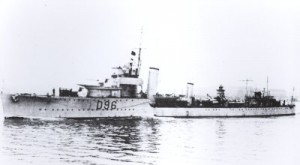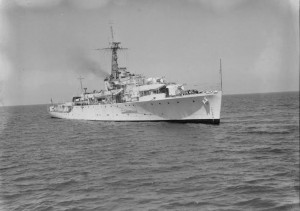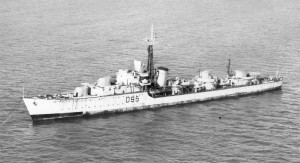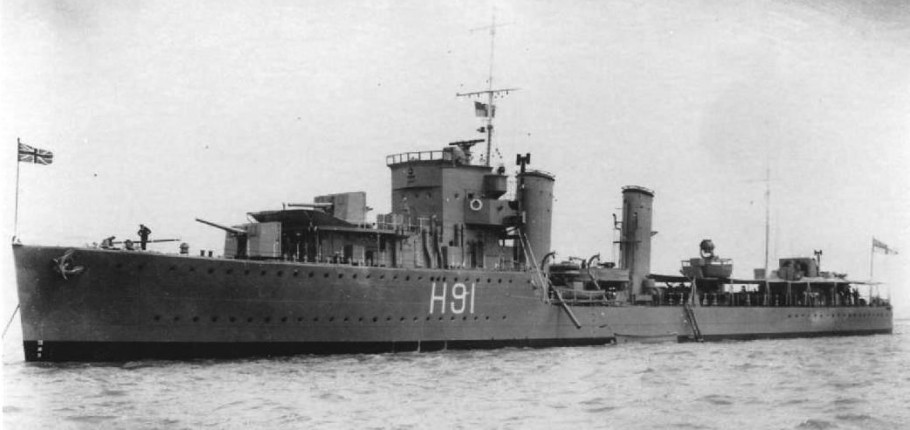
Destroyers – World War 2
At the start of World War II, the Royal Navy operated a range of destroyer classes. Some of these were legacies of World War I, some were designed during the inter-war years and the rest were the result of wartime experience and conditions.
Most destroyers were fitted with four or six main guns, smaller calibre canon or machineguns, torpedoes, mine sweeping equipment, depth charges and asdic (sonar). Some destroyers were fitted for mine laying, although this was unusual. Destroyers usually had a top speed of over 35 knots.
During the war, 153 British, Canadian and Australian destroyers were lost.
HMS Ambuscade
- Type. Destroyer
- Class. Tribal
- Pennant. D38,I38
- Builder. Yarrow
- Speed. 37 Knots
- Ordered. 12/06/1924
- Laid Down. 08/12/1934
- Launched. 14/01/1926
- Commissioned. 09/04/1924
- Fate. Scrapped 1947
HMS Ambuscade was a Tribal Class Destroyer laid down at Yarrow’s Glasgow shipyard on 8 December 1934 and was launched on 14 January 1926. Following commissioning, Ambuscade joined the Atlantic Fleet for trials, undergoing repair and modifications at Chatham Dockyard between September and November that year, before returning to normal duties. Ambuscade’s re-entered at Harwich in May 1940 with the Sixteenth Destroyer Flotilla, receiving a new pennant number, I38. On 10 June, Ambuscade took part in the attempt to evacuate troops of the 51st (Highland) Division from Saint-Valery-en-Caux (Operation Cycle). Ambuscade was damaged by German shell fire while embarking troops, and on the journey back to Portsmouth, she took the destroyer HMS Boadicea in tow after the latter was badly damaged by German dive bombers. Following repair, Ambuscade rejoined her Flotilla, carrying out anti-invasion patrols and convoy escort operations
Ambuscade was used for shock trials during 1946, and was sold for scrapping in November that year, being broken up by West of Scotland Shipbreaking Company at Troon from March 1947.
HMS Anthony
- Type. Destroyer
- Class. A
- Pennant. H40
- Builder. Scott’s
- Speed. 35 Knots
- Ordered. 06/03/1928
- Laid Down. 30/07/1928
- Launched. 24/04/1929
- Commissioned. 14/02/1930
- Fate. Scrapped 21/02/1948
HMS Anthony was launched 24th April 1929 by Scott’s Greenock. She entered service in the 3rd Destroyer Flotilla on 11th March 1930, operating in the Mediterranean until 1937 when she returned to United Kingdom waters. On the outbreak of war she escorted convoys until April 1940 when she assisted in the Dunkirk evacuation. She took part in Operation Torch, the invasion of North Africa in October 1942 and Operation Husky, the invasion of Sicily in July 1943. In February 1944 she took part in the sinking of the German submarine U761. After September 1944 she returned to the United Kingdom, and became a target ship for practice attacks by aircraft, until January 1946 when she entered the Reserve Fleet. In May 1948 she arrived at Troon, Ayrshire for scrapping.
HMS Arethusa
- Type. Destroyer
- Class. Arethusa
- Pennant. 26
- Builder. Chatham
- Speed. 32 Knots
- Ordered. 01/09/1932
- Laid Down. 25/01/1933
- Launched. 06/03/1934
- Commissioned. 23/05/1935
- Fate. Scrapped 1950
HMS Arethusa was a Arethusa Class Destroyer built by Chatham Dockyard, with the keel being laid down on 25 January 1933. She was launched on 6 March 1934, and commissioned 21 May 1935. Arethusa was assigned to the 3rd Cruiser Squadron in the Mediterranean on completion, and was still there at the onset of World War II in September 1939. However, early in 1940 she and her sister HMS Penelope were recalled to the Home Fleet, where they formed the 2nd Cruiser Squadron with the remainder of the class. She participated in the Norwegian Campaign in April 1940, but on 8 May she joined the Nore Command, where she supported the defending forces in Calais and later aided the evacuations from French Atlantic ports.
On 28 June 1940 she was a component of the newly formed Force “H” at Gibraltar, with whom she participated in the action against Vichy French forces at Mers el Kebir in July 1940. With Force “H” she took part in convoy protection patrols in the Atlantic and operated in the Mediterranean.
During the Bismarck sortie in May 1941 she was employed in Iceland and Faroes waters, but by July she had returned to the Mediterranean, where she escorted Malta convoys and ran supply trips to the island herself. Towards the end of 1941 she returned to home waters and took part in the Lofoten raid in December, where she was damaged by near misses. After refit and repair at Chatham until April 1942, she returned to the Mediterranean in June 1942, where she joined the 15th Cruiser Squadron, operating mostly in support of the resupply of Malta.
HMS Ashanti
- Type. Destroyer
- Class. Tribal
- Pennant. F51
- Builder. William Denny
- Laid Down. 23/11/1936
- Launched. 05/11/1937
- Commissioned. 21/12/1938
- Fate. Scrapped 12/04/1949
HMS Ashanti was a Tribal Class Destroyer launched on the 5th November 1937 by William Denny. When war began; the 6th D.F. was cruising with the Home Fleet and French ships in the North Atlantic. Gradually the ships saw less and less of each other as wartime patrols and new missions developed. Over the next several months, Ashanti’s main responsibilities were anti-submarine patrol followed by some brief escort duties in December. Ashanti began 1940 with more anti-submarine patrols, convoy escort duties and supporting capital ships. The Royal Navy spent a quarter of a million pounds on repairs. When the refit was over, more problems were discovered and she was held up again. This time Ashanti was passed over and went into reserve at Rosyth, Scotland and was later laid up at Harwich.
In 1948, she was used in damage control tests in Loch Striven. Ashanti had survived North Atlantic gales, the Norwegian Campaign, running aground, Arctic convoys, the invasion of North Africa, U-boats, aircraft, and some of the toughest destroyer fighting of the Second World War. On 12 April 1949, she could no longer hold on and was destined to be broken up at Troon.
HMS Basilik
- Type. Destroyer
- Class. Beagle
- Pennant. H11
- Builder. Henry Robb
- Speed. 35 Knots
- Ordered. 04/03/1929
- Laid Down. 19/08/1929
- Launched. 06/08/1930
- Commissioned. 04/03/1931
- Fate. Sunk 01/06/1940
HMS Basilisk was a B-class destroyer launched on the 6th August 1930 by Henry Robb. Initially assigned to the Mediterranean Fleet, she was transferred to the Home Fleet in 1936. History: 2nd November 1939 – In passage from Harwich to Dover to cover mine laying mission HW.
The ship escorted convoys and conducted anti-submarine patrols early in World War II before participating in the Norwegian Campaign. Basilisk was sunk by German aircraft during the Dunkirk evacuation on the 1ST June 1940.
HMS Beagle
- Type. Destroyer
- Class. B
- Pennant. H30
- Builder. John Brown
- Speed. 35 Knots
- Laid Down. 11/10/1929
- Launched. 19/10/1930
- Commissioned. 09/04/1931
- Fate. Scrapped 15/01/1946
HMS Beagle was a B-class destroyer built by John Brown’s Shipyard and launched on the 19th October 1930. Initially assigned to the Mediterranean Fleet, she was transferred to the Home Fleet in 1936. The ship was tasked to blockade the German-occupied ports in France from 12 April and accepted the surrender of the German garrison of the Channel Islands together with her sister Bulldog.
History: 29th October 1939 – Joined new 23rd Destroyer Flotilla at Harwich
2nd November 1939 – In passage from Harwich to Dover to cover mine laying mission.
On 9 May Beagle was placed in reserve fifteen days later and was approved for scrapping on 22 December. She was turned over for scrapping on 15 January 1946 at Rosyth and moved to the shipbreaking yard of Metal Industries, Limited two days later.
HMS Blanche
- Type. Destroyer
- Class. B
- Pennant. H47
- Builder. Hawthorn Leslie
- Ordered. 04/03/1929
- Laid Down. 29/07/1929
- Launched. 29/05/1930
- Fate. 13/11/1939
HMS Blanche was a B-class destroyer built for the Royal Navy in 1930. The ship was ordered on 4 March 1929 from Hawthorn Leslie of Hebburn. She was laid down on 29 July 1929, and launched on 29 May 1930. After her commissioning she was assigned to the 4th Destroyer Flotilla with the Mediterranean Fleet until 1936.
History: 29th October 1939 – Joined new 23rd Destroyer Flotilla at Harwich, 2nd November 1939 – In passage from Harwich to Dover to cover mine laying missions.
Blanche was assigned to the 19th Destroyer Flotilla when World War II began and spent the next two months escorting convoys and patrolling in the Channel and North Sea. The ship and her sister Basilisk were escorting the minelayer Adventure on the morning of 13 November in the Thames Estuary when they entered a minefield laid the night before by several German destroyers. Adventure and Blanche both struck mines; the latter lost all power and capsized at 0950. One man was killed and twelve more were wounded. She was the first British destroyer sunk by the Germans during the war on the 13th of November 1939.
ORP Blyskawica
- Type. Destroyer
- Class. Grom-class destroyer
- Pennant. 51
- Builder. J.Samuel White
- Launched. 01/10/1936
- Commissioned. 25/11/1937
- Speed. 39 Knots
- Fate. Museum ship
ORP Błyskawica was a Grom-class destroyer which served in the Polish Navy during World War II and is the only ship of the Polish Navy awarded the Virtuti Militari medal.
Blyskawica was laid down on 1 October 1935 at J. Samuel White’s Cowes, Isle of Wight shipyard, and was launched on 1 October 1936.
Blyskawica was 114 metres long overall and 109 metres between perpendiculars, with a beam of 11.3 metres and a draught of 3.1 metres. Displacement was 2,144 long tons standard and 3,383 long tons full load. The ship’s crew consisted of 180 officers and men.
During the war, she logged 146,000 nautical miles (270,000 km) and escorted eighty-three convoys. In combat she damaged three U-boats, helped sinking other ships and shot down at least four aircraft
In late 1945 and early 1946, the Błyskawica along with the destroyer HMS Onslow took part in Operation Deadlight, the scuttling of over 100 German U-Boats.
Blyskawica is preserved as a museum ship in Gdynia, the oldest preserved destroyer in the world.
HMS Boadicea
- Type. Destroyer
- Class. B
- Pennant. H65
- Builder. Hawthorn Leslie
- Speed. 35 Knots
- Ordered. 04/03/1929
- Laid Down. 11/07/1929
- Launched. 23/09/1930
- Commissioned. 07/04/1931
- Fate. Sunk 13/06/1940
HMS Boadicea was a B-class destroyer launched on the 23rd September 1930. Initially assigned to the Mediterranean Fleet, she was transferred to the Home Fleet in 1936. On 29 August, Boadicea was assigned to the 19th Destroyer Flotilla based at Dover where she escorted the troopships of the British Expeditionary Force through October. The ship was then transferred to the 22nd Destroyer Flotilla at Harwich for two months before rejoining the 19th Flotilla where she escorted convoys through the English Channel.
History: 29th October 1939 – Joined new 23rd Destroyer Flotilla at Harwich, 2nd November 1939 – In passage from Harwich to Dover to cover mine laying mission HW, 19th November 1939 – Sailed Harwich to investigate a Belgian steamer in the North Sea, 21st November 1939 – Sailed Harwich for a sweep in the North Sea in operation GT.1
Boadicea was sunk on 13 June off Portland Bill by two torpedoes dropped by Junkers Ju 88 medium bombers while escorting a convoy of merchant ships to France. Only 12 of her crew of 182 survived.
HMS Boreas
- Type. Destroyer
- Class. B
- Pennant. H77
- Builder. Palmers
- Laid Down. 22/07/1929
- Launched. 18/07/1930
- Speed. 35 Knots
- Fate. Scrapped 15/04/1944
HMS Boreas was a “B”-class destroyer launched on the 18th July 1930 by Palmers. Initially assigned to the Mediterranean Fleet, she was transferred to the Home Fleet in 1936. The ship was assigned to the 19th Destroyer Flotilla on the start of the war and spent the first six months on escort and patrol duties in the English Channel and North Sea. While assisting the damaged minesweeper Sphinx on 4 February 1940 in the Moray Firth, Boreas’s stern was damaged and she required repairs that lasted until the following month. The ship was attached to the 12th Destroyer Flotilla on 29 March until she was damaged in a collision with her sister ship Brilliant on 15 May. Her repairs lasted until 19 June and Boreas was assigned to the 1st Destroyer Flotilla at Dover upon their completion. On 25 July, the ship engaged German E-boats off Dover Harbour together with Brilliant and was badly damaged by German Junkers Ju 87 Stuka dive bombers after she was ordered to withdraw. Her bridge was hit twice by bombs that killed one officer and twenty crewmen.
The ship was loaned to the Royal Hellenic Navy on 10 February and recommissioned by them on 25 March as Salamis. She was damaged while working up at Scapa Flow and was under repair at Hull from 28 April to 13 June. Salamis was assigned to escort duty at Gibraltar until October when she was transferred to the Aegean where she served with the 12th (Greek) Destroyer Flotilla for the rest of the war. The ship was used as a training ship after the war until she was returned to the Royal Navy at Malta on 9 October 1951. Salamis arrived at Rosyth under tow on 15 April 1952 to be broken up by Metal Industries Limited.
HMS Brazen
- Type. Destroyer
- Class. B
- Pennant. H80
- Builder. Palmers
- Speed. 35 Knots
- Ordered. 22/03/1929
- Laid Down. 22/07/1929
- Launched. 25/07/1930
- Commissioned. 08/04/1931
- Fate. Sunk 20/07/1940
HMS Brazen was a B-class destroyer built for the Royal Navy in 1930. Initially assigned to the Mediterranean Fleet, she was transferred to Home Fleet in 1936. She was laid down on 22 July 1929, and launched on 25 July 1930, Brazen was completed on 8 April 1931 at a cost of £220,342, After her commissioning, she was assigned to the 4th Destroyer Flotilla with the Mediterranean Fleet until the end of 1935. The ship received a refit at Devonport from August to October 1933 and another at Malta a few months later. Brazen was assigned to the Home Fleet in 1936. The ship was reassigned to the 19th Destroyer Flotilla in August, shortly before World War II began. She spent the next seven months escorting convoys and patrolling in the English Channel and the North Sea. On 13 October, Brazen rescued three survivors from German submarine U-40 which had sunk after striking a mine a few hours earlier.
On 30 May, the ship was en route to Harwich when she struck some submerged wreckage and suffered damage that required five weeks to repair. Brazen was transferred to the 1st Destroyer Flotilla, based at Dover, upon their completion, where she began escorting coastal convoys. Whilst escorting Convoy CW7 on 20 July, the ship was attacked by German dive bombers. The shock effect from several near misses broke her keel and then she was hit in the engine room.
HMS Brilliant
- Type. Destroyer
- Class. B
- Pennant. H84
- Builder. Swan Hunter
- Speed. 35 Knots
- Ordered. 22/03/1929
- Laid Down. 08/07/1929
- Launched. 09/10/1930
- Commissioned. 21/02/1931
- Fate. Scrapped 21/02/1948
HMS Brilliant was built by Swan Hunter and launched on the 9th October 1930, Initially assigned to the Mediterranean Fleet, she was transferred to the Home Fleet in 1936. At the outbreak of war in September 1939, Brilliant was assigned to the 19th Destroyer Flotilla at Dover and spent the time before the Battle of France escorting convoys and minelaying operations. The ship was reassigned to the 1st Destroyer Flotilla in the English Channel in November. On 24 December 1944, Brilliant was escorting the troopship Leopoldville when the ship was struck by a torpedo from U-486, 5½ nautical miles off Cherbourg. Brilliant was able to rescue about 500 survivors from the damaged troopship, but due to various communication failures, no other vessels reached her before she sank and 764 died. The ship collided with the Canadian corvette Lindsay in dense fog on 21 January 1945 off the Isle of Wight. Brilliant’s bow was badly damaged and she was transferred to Antwerp, the Netherlands, for permanent repairs after emergency repairs were made at Portsmouth. They were not completed until 23 April and the ship returned to Portsmouth for conversion to a submarine target and escort vessel. This was completed on 26 May and Brilliant escorted the light cruiser Jamaica with King George VI aboard as he visited the Channel Islands on 7 June. From 13 June, based at Holy Loch, Scotland, she escorted surrendered U-boats as part of Operation Deadlight before being paid off into reserve in November 1945.
29 April 1946 Brilliant was allocated to the Target Trials Committee on 11 September and was used evaluate the shock effects of a 1,090-pound (490 kg) underwater explosion in April 1947. The ship was turned over to the British Iron and Steel Company for scrapping on 21 February 1948. She was broken up beg
HMS Bulldog
- Type. Destroyer
- Class. B
- Pennant. H91
- Builder. Swan Hunter
- Speed. 35 Knots
- Ordered. 22/03/1929
- Laid Down. 10/08/1929
- Launched. 06/12/1930
- Commissioned. 08/04/1931
- Fate. Scrapped 22/12/1945
HMS Bulldog was a B-class destroyer built for the Royal Navy from 1929 to 1931. The ship was ordered on 22 March 1929 from Swan Hunter at Wallsend, under the 1928 Naval Programme. She was laid down on 10 August 1929, and launched on 6 December 1930. Initially assigned to the Mediterranean Fleet, she was transferred to the Home Fleet in 1936. Bulldog saw service throughout World War II on convoy escort duty during the Battle of the Atlantic and in the Arctic. Her most notable actions were the capture of a complete Enigma machine and codebooks from the German submarine U-110 in 1941, and sinking another German submarine in 1944. Bulldog also accepted the surrender of the German garrison of the Channel Islands on 9 May 1945. Redundant after the war, she was broken up for scrap in 1945.
ORP Burza
- Type. Destroyer
- Class. Wicher
- Pennant. H73
- Builder. Chantiers Naval Francais
- Laid Down. 01/11/1927
- Launched. 16/04/1929
- Commissioned. 10/07/1932
- Speed. 33.8 Knots
- Fate. Scrapped 1977
ORP Burza was a Wicher-class destroyer of the Polish Navy, Burza was ordered on 2 April 1926 from the French shipyard Chantiers Naval Francais together with her sister ship Wicher. She entered service in 1932. On 30 August 1939 the Polish destroyers ORP Burza, Błyskawica and Grom were ordered to execute the Peking Plan, and the warships headed for Great Britain. On 1 September 1939, Polish destroyers met the British destroyers Wanderer and Wallace. The British ships led the Polish ships to Leith, and at night the Polish destroyers arrived at Rosyth.
Burza assisted British forces off Norway in April 1940 and in the English Channel in May, 1940. Burza escorted convoy HX-217 as part of Escort Group B-6. While attached to Escort Group B-3, Burza escorted convoys ONS-167, HX-228, and SL-147/MKS-38. Burza was detached from ONS-167 to defend Convoy ON-166. While attached to Support Group 8, Burza escorted convoy SC-145 and the October 1943 convoy to establish British air bases in the Azores. In 1944, Burza became a training ship, and in 1945 she became a submarine tender for Polish submarines. The Polish crew left the ship in 1946, when Burza was transferred to the Royal Navy.
In 1951, the ship was returned to the Polish Navy and towed to Gdynia in July. Burza was overhauled and entered service in 1955. In 1960, she became a museum ship. After Błyskawica replaced her in that role, she was scrapped in 1977.
HMS Camperdown
- Type. Destroyer
- Class. Battle
- Pennant. R32
- Builder. Fairfield
- Speed. 35 Knots
- Ordered. 27/04/1942
- Laid Down. 30/10/1942
- Launched. 08/02/1944
- Commissioned. 18/06/1945
- Fate. Scrapped 1970
HMS Camperdown was a Battle-class destroyer built by Fairfield’s and launched on 8 February 1944 and commissioned on 18 June 1945. Camperdown was deployed to the Far East as part of the 19th Destroyer Flotilla, visiting a variety of ports, as well as performing a number of naval exercises on the way. The following year, Camperdown, along with the rest of the 19th Flotilla, after visits to many Far East ports, and a trip through the Mediterranean, returned to the United Kingdom. She was subsequently placed in Reserve.
In 1953, at Plymouth, Camperdown was accidentally rammed by Coreopsis, a Flower class corvette (renamed Compass Rose for her role in the film The Cruel Sea), causing damage. In 1957, the ship joined the 3rd Destroyer Flotilla of the Home Fleet, and just the following year, suffered a fire. In 1960, Camperdown joined the 1st Destroyer Squadron, with spells with the Home and Mediterranean Fleets. In 1962, Camperdown was placed on the disposal list and in 1970; she was finally scrapped at Faslane.
HMS Charlestown
- Type. Destroyer
- Class. Town
- Pennant. L21
- Builder. Newport
- Laid Down. 05/04/1918
- Launched. 04/07/1918
- Commissioned. 23/09/1940
- Speed. 35 Knots
- Fate. Scrapped 1947
HMS Charlestown was launched on the 04th July 1918 in Newport USA. the destroyer was assigned to the 17th Destroyer Division and arrived at Belfast, Northern Ireland on 8 October. She took part in several minelaying operations along the west coast of Scotland. In September 1943, Charlestown was allocated to the Rosyth Escort Force to escort convoys along the east coast of Britain.
History: Damaged in collision with the steamer Florizell off Harwich, England, during December 1944, she was reduced to reserve at Grangemouth, Scotland, and paid off from 15 January 1945. She was finally sold for scrap on 4 March 1947 at Sunderland.
HMS Codrington
- Type. Destroyer
- Class. A
- Pennant. D65
- Builder. Swan Hunter
- Laid Down. 20/06/1928
- Launched. 08/08/1929
- Commissioned. 04/06/1930
- Speed. 37 Knots
- Fate. Sunk 27/07/1940
HMS Codrington was an A-class destroyer ordered on 6 March 1928 from the yards of Swan Hunter & Wigham Richardson, Wallsend, She was as laid down on 20 June 1928 and was launched on the 8 August 1929. She was commissioned on 4 June 1930. After carrying out acceptance trials throughout February 1930, she was assigned to operate with the Mediterranean and Home Fleets. She spent a period in the reserve at Devonport Naval Base, but was refitted in 1938, being recommissioned on completion of the refit in August 1939 in time to participate in the Second World War. After being recommissioned after her refit, Codrington was nominated as the leader of the 19th Destroyer Flotilla, as part of the Nore Command. She then took passage to Sheerness to take up her war station. She sailed to Dover in September and on 4 September began to escort the convoys carrying the British Expeditionary Force to France. She remained in the English Channel throughout October, before being transferred to Harwich to defend against a perceived threat of a German attack on the Low Countries. She was back in Dover in December, and on 4 December Codrington embarked King George VI and transported him to Boulogne for his visit to the British Expeditionary Force in France.[1] Codrington re-embarked him on 10 December and brought him back to Dover. On 22 December, she joined the escort — consisting of Esk, Express and Brazen — for the auxiliary minelayer Princess Victoria during a mine lay in the Dover Barrage.
In July, Codrington was deployed out of Dover for convoy defence and patrol duties in the English Channel. She put in to port near the end of the month for a boiler clean, alongside the depot ship Sandhurst in the Submarine Basin. The port came under air attack on 27 July and a bomb fell alongside Codrington. The subsequent explosion broke her back and she sank.
HMS Cossack
- Type. Destroyer
- Class. Tribal
- Pennant. F03
- Builder. Vickers Armstrong
- Ordered. 1936
- Laid Down. 09/06/1936
- Launched. 08/06/1937
- Commissioned. 07/06/1938
- Speed. 36 Knots
- Fate. Sunk 27/10/1941
HMS Cossack was a Tribal-class destroyer ,laid down at the Walker Naval Yard of Vickers-Armstrong’s in Newcastle upon Tyne on 9 June 1936, launched on 8 June 1937 by Mrs S. V. Goodall, commissioned on 7 June 1938 and completed on 14 June 1938.
In May 1941, she participated in the pursuit and destruction of the Bismarck. While escorting Convoy WS-8B to the Middle East, Cossack and four other destroyers broke off on 26 May, and headed towards the area where Bismarck had been reported. They found her that evening and made several torpedo attacks in the evening and into the next morning. No hits were scored, but they kept her gunners from getting any sleep, making it easier for the battleships to attack her the next morning.
On 23 October 1941, Cossack was escorting a convoy from Gibraltar to the United Kingdom when she was struck by a single torpedo fired by the German submarine U-563 commanded by Klaus Bargsten. She was taken in tow by a tug from Gibraltar on 25 October, but the weather worsened and the tow was slipped on 26 October. Cossack sank in the Atlantic west of Gibraltar on 27 October 1941. 159 of her crew were lost.
HMS Cotswold
- Type. Destroyer
- Class. Hunt
- Pennant. F154, L54
- Builder. Yarrow
- Ordered. 11/04/1939
- Laid Down. 11/10/1939
- Launched. 18/07/1940
- Commissioned. 16/11/1940
- Speed. 27.5 Knots
- Fate. Scrapped 11/09/1957
HMS Cotswold was launched by Yarrow Shipbuilders on the 18th July 1940 Paid-off after VJ Day and was refitted at Portsmouth before being reduced to Reserve status. Laid-up at Harwich on 29th June 1946 the ship remained there until transferred to Barrow in 1953. Placed on the Disposal List in January 1956 she was towed to Harwich and hulked there prior to sale to Bisco in August 1957 for demolition by T W Ward at Grays, Essex. The ship arrived in tow at the breaker’s yard on 11th September that year.
HMS Diamond
- Type. Destroyer
- Class. D
- Pennant. H22
- Builder. Vickers Armstrong
- Ordered. 02/02/1931
- Laid Down. 29/09/1931
- Launched. 08/04/1932
- Commissioned. 02/11/1932
- Speed. 36 Knots
- Fate. Sank 27/04/1941
HMS Diamond was a D-class destroyer ordered on 2 February 1931 under the 1930 Naval Estimates, and was laid down at Vickers-Armstrong’s yard at Barrow-in-Furness on 29 September 1931. She was launched on 8 April 1932 and completed on 3 November 1933, at a total cost of £223,509.
On the evening of 26 April, Diamond was in the Argolic Gulf with three light cruisers, three other destroyers and two troopships. The force began evacuating British, Australian and New Zealand troops from Nauplia. The cruisers HMS Calcutta and HMS Orion and destroyers HMS Hotspur and HMS Isis embarked nearly 2,500 troops and, at 03:00 the next morning, Calcutta ordered the evacuation force to sail. One of the troop ships, the Dutch ocean liner Slamat, disobeyed and continued to embark troops. Slamat embarked 500 troops before she eventually obeyed orders at 04:15, and the convoy sailed for Crete.
Near the mouth of the Argolic Gulf a Staffel of nine Luftwaffe Junkers Ju 87 Stuka dive-bombers from Jagdgeschwader 77 attacked the convoy at either 06:45 or 07:15. Slamat was hit, set afire and began to abandon ship. Calcutta ordered Diamond to go alongside Slamat to rescue survivors while the rest of the convoy continued to try to reach Souda Bay in Crete. At 08:15 Diamond reported that she was still rescuing survivors and still under air attack. By then three destroyers had reinforced the convoy so Calcutta sent one of them, HMS Wryneck, to assist Diamond. Slamat was afire from stem to stern when Diamond fired a torpedo that sank her in a coup de grâce. Diamond reported at 09:25 that she had rescued most of the survivors and was proceeding to Souda Bay.
At about 13:15, an air attack by German Messerschmitt Bf 109 fighters and Junkers Ju 88 bombers sank both destroyers within minutes. Wryneck launched her whaler, and each destroyer launched her three Carley floats. Survivors in the whaler set off east past Cape Maleas, towing two Carley floats and their occupants. In the evening the wind increased, caus After 1900 hrs on 27 April the Vice Admiral, Light Forces, Henry Pridham-Wippell, became concerned that Diamond had not returned to Souda Bay and was not answering radio signals. Wryneck had been ordered to keep radio silence so no attempt was made to radio her. Pridham-Wippell sent the destroyer HMS Griffin to the position where Slamat had been lost. She found 14 survivors in two Carley floats that night, more floats and another four survivors in the morning, and took the survivors to Crete.
Survivors in Wryneck’s whaler reached Crete in three stages. On 28 April they aimed for the island of Milos in the Aegean Sea, but were too exhausted so they landed at Ananes Rock, about 13 nautical miles (24 km) southeast of Milos. There they met a caïque full of Greek refugees and British soldiers evacuated from Piraeus, who were sheltering by day and sailing only by night to avoid detection. In the evening everyone left Ananes and headed south for Crete, with most people in the caïque and five being towed in the whaler. On 29 April the caïque sighted a small landing craft that had left Porto Rafti near Athens. She took aboard everyone from the caïque and whaler, and the next day they reached Souda Bay.
HMS Eglinton
- Type. Destroyer
- Class. Hunt
- Pennant. F87
- Builder. Vickers Armstrong
- Ordered. 21/03/1939
- Laid Down. 08/06/1939
- Launched. 28/12/1939
- Commissioned. 28/08/1940
- Speed. 27.5 Knots
- Fate. Scrapped 28/05/1956
HMS Eglinton was a Hunt Class Escort Destroyer ordered from Vickers Armstrong, Newcastle on 21st March 1939 She was laid down on 8th June 1939 and launched on 28th December 1939.
Eglinton was Paid off after VJ Day and reduced to Reserve status at Harwich. In 1950 she was transferred to Portsmouth and later went to Hartlepool. Sold to Bisco for demolition by Hughes Bolcow at Blyth, she arrived there in tow on 28th May 1956.
HMS Esk
- Type. Destroyer
- Class. E
- Pennant. H15
- Builder. Swan Hunter
- Ordered. 01/11/1932
- Laid Down. 24/03/1933
- Launched. 06/03/1934
- Commissioned. 28/09/1934
- Speed. 36 Knots
- Fate. Sank 31/08/1940
HMS Esk was an E-class destroyer launched on the 6 March 1934 by Swan Hunter, Esk was converted to a minelayer when World War II began in September 1939, and spent most of her time laying mines The ship was commissioned on 28 September 1934, at a total cost of £247,279,During the Munich Crisis, Esk and her sister ship HMS Express were temporarily attached to the 9th Destroyer Flotilla at the Nore, and practiced minelaying on 3 October 1938. Esk was reduced to reserve on 24 June 1939, and was not recommissioned until 2 August. She attended the Reserve Fleet Review on the 15th, and then began conversion as a minelayer beginning on 28 August. On 31 August 1940, she sailed with Intrepid, Icarus, Ivanhoe and Express to lay a minefield off the Dutch coast, north of Texel. Express hit a mine in a newly-laid German field that night and had her bow blown off. Esk closed to assist her and almost immediately struck another mine. Some 15 minutes later, there was another explosion amidships which caused Esk to break in two, and she quickly sank.
15th November 1939 – Sailed Harwich, 17th November 1939 – Arrived Harwich for mine laying in the Thames approaches in operation RG.
HMS Eskimo
- Type. Destroyer
- Class. Tribal
- Pennant. L75, F75, G75
- Builder. Vickers
- Ordered. 19/06/1936
- Laid Down. 05/08/1936
- Launched. 03/09/1937
- Commissioned. 30/12/1938
- Speed. 36 Knots
- Fate. Scrapped 27/06/1949
HMS Eskimo was a Tribal class Destroyer launched on the 3rd September 1937 by Vickers Early in 1946, her torpedo tubes were removed and a type of prefabricated house was placed on her deck. Her screws were removed to prevent her from touching bottom, and then she was towed to Queenborough, England. Eskimo ended her days as an accommodation and headquarters ship for minesweepers, wreck-disposal vessels; salvage craft which were clearing the Thames and Medway estuaries. She was then laid up, first at Sheerness, then at Harwich and finally used as a target in the Gareloch. On 27 June 1949, Eskimo was sold for scrapping at Troon.
HMS Exmoor
- Type. Destroyer
- Class. Hunt
- Pennant. L61
- Builder. Swan Hunter
- Ordered. 1939
- Laid Down. 08/06/1939
- Launched. 25/01/1940
- Commissioned. 18/10/1940
- Speed. 27.5 Knots
- Fate. Sunk. 25/02/1941
HMS Exmoor was a Hunt Class Destroyer launched on the 25 January 1940. Exmoor was ordered under the 1939 Naval Building Programme from Parsons Marine Steam Turbines Company, with the hull building being subcontracted to the Vickers-Armstrong’s yard, Tyneside. She was commissioned into service on 18 October 1940, and after working up, was assigned to the 16th Destroyer Flotilla at Scapa Flow.
January Exmoor was part of the escort for HMS Queen Elizabeth as she sailed from Portsmouth to Rosyth. Exmoor then sailed to Harwich to begin escorting coastal convoys through the North Sea with the 16th Destroyer Flotilla. She carried out these duties into February, and on 23 February was deployed with HMS Shearwater to escort a convoy from the Thames estuary to Methil. The convoy was attacked by E-boats as it passed off Lowestoft on 25 February. Exmoor suffered an explosion aft, suffering major structural damage and rupturing a fuel supply line. A fire soon broke out which spread rapidly. Exmoor capsized and sank in ten minutes. The survivors were picked up by the Shearwater and the trawler Commander Evans, and were taken to Yarmouth. The Exmoor had either been hit by the E-Boat S30 or had struck a mine.
HMS Exmouth
- Type. Destroyer
- Class. E
- Pennant. H02
- Builder. Portsmouth Dockyard
- Laid Down. 15/03/1933
- Launched. 30/01/1934
- Commissioned. 09/09/1934
- Speed. 36 Knots
- Fate. Sunk. 21/01/1940
HMS Exmouth was an E-class destroyer flotilla leader Launched at Portsmouth Dockyard on 30 January 1934. Exmouth and her flotilla were initially assigned to the Home Fleet upon the outbreak of World War II in September 1939. She was escorting the merchant Cyprian Prince on 21 January 1940 when she was spotted by the German submarine U-22, and torpedoed at 05:35. She sank with the loss of all hands.
HMS Express
- Type. Destroyer
- Class. E
- Pennant. H61
- Builder. Swan Hunter
- Ordered. 1931
- Laid Down. 23/03/1933
- Launched. 29/05/1934
- Commissioned. 31/10/1934
- Speed. 35.5 Knots
- Fate. Scrapped 1955
HMS Express was an E-class destroyer launched on 29 May 1934 by Swan Hunter. On the outbreak of war in September 1939 during the Invasion of Poland, Express was assigned to the 20th minelaying destroyer flotilla, initially based at Portsmouth before moving to Immingham on the North Sea. Express spent the first year of the war laying defensive minefields in British waters and offensive minefields off enemy coasts with the 20th Flotilla. In late May 1940, Express was one of several dozen destroyers ordered to help evacuate the British Expeditionary Force from Dunkirk, and was one of the first to arrive and begin taking troops off the beaches. Later troops were taken off from Dunkirk Harbour. The Express and the destroyer Shikari were the last ships to leave Dunkirk with troops before the evacuation ended on June 4. She brought out 2,795 troops over the course of the evacuation. She was damaged by bombing, but was hastily repaired-in-process to continue taking part in the Dunkirk evacuation.
On 31 August 1940, she left Immingham to lay an offensive mine field off the coast of the Netherlands. During the night, express struck a mine, losing her entire bow up to the bridge. Esk and Ivanhoe then struck mines while trying to go to her assistance. Express was towed back to Britain, having lost 4 officers and 55 ratings.
In June 1943, she was transferred to the Royal Canadian Navy and rechristened HMCS Gatineau. She served with distinction in the Atlantic. In 1955, she was struck from the boards and sold for scrap.
HMS Fearless
- Type. Destroyer
- Class. F
- Pennant. H67
- Builder. Cammell Laird
- Ordered. 1932
- Laid Down. 17/07/1933
- Launched. 12/05/1934
- Commissioned. 22/12/1934
- Fate. 23/07/1941
HMS Fearless was ordered from Cammell Laird at Birkenhead under the 1932 Programme. She was laid down on 17 July 1933, and launched on 12 May 1934.
On 31 January 1941 she took part in “Operation Picket”, an air attack on the Tirso Dam on Sardinia, and also in Operation Grog, a naval bombardment of Genoa on 6 February. In March Fearless was deployed with three other destroyers of the Flotilla and the cruiser Sheffield to intercept a Vichy convoy. A later attempt to capture the French merchant ship Bangkok off the port of Ghazaouet, Algeria, was prevented by shore battery fire. In early April Fearless and four other destroyers escorted the Sheffield, battlecruiser Renown, and the carrier Ark Royal in Operation Winch, which delivered 12 Hurricane fighter aircraft to Malta. Later in the month she was part of the screen for the same ships escorting Force S, a group of reinforcement ships for the Fleet in Alexandria
In early May she was part of destroyer screen with five other destroyers for the battleship Queen Elizabeth, and the cruisers Naiad, Fiji and Gloucester which were joining the Fleet in the Eastern Mediterranean. This was part of Operation Tiger which included a supply convoy taking tanks to the Middle East and the transfer of warships. After arrival in Malta on the 12th Fearless carried out a minesweeping operation to enable the ships of 5th Destroyer Flotilla to safely leave harbour for an offensive operation against Italian convoys. On the 19th she and three other destroyers escorted the heavy cruiser London to cover the delivery of further aircraft to Malta by the carriers Ark Royal and Furious.
In June she was deployed in the Atlantic on anti-submarine operations with the Flotilla. On the 16th Fearless and four other destroyers sank the U-138 off Gibraltar. On the 22nd she was deployed with four other destroyers to intercept a German supply ship spotted heading towards the French coast. The next day the Flotilla intercepted the SS Alstertor which was scuttled by her crew on the approach of the British ships. They rescued 78 British POWs taken from ships sunk by German raiders and the crew.
In July Fearless resumed duty with “Force H” in the Mediterranean. On the 20th she joined Force X in “Operation Substance”, another Malta convoy. On the 23rd whilst screening Ark Royal she was torpedoed and heavily damaged by an Italian Savoia-Marchetti SM.79. Her crew was rescued by Forester, which then sank the wrecked and burning ship with torpedoes about 50 nautical miles north-north-east of Bône, Algeria.
HMS Gallant
- Type. Destroyer
- Class. G
- Pennant. H59
- Builder. Alexander Stephen
- Ordered. 05/03/1934
- Laid Down. 15/09/1934
- Launched. 26/09/1935
- Commissioned. 25/02/1936
- Speed. 36 Knots
- Fate. Scrapped 1953
HMS Gallant was a G Class Destroyer launched on the 26th September 1935 by Alexander Stephen & Sons, Glasgow. When World War II began in September 1939, Gallant was in the Mediterranean, but she and her entire flotilla were transferred to the Western Approaches Command at Plymouth in October. After a boiler cleaning, the ship was reassigned at the end of the month to the Nore Command in Harwich for patrol and escort duties. On 20 March 1940 she escorted the armed merchant cruisers Cilicia and Carinthia after they collided. The ship was refitted at Southampton between 28 March and 30 April and rejoined her flotilla at Harwich the next day. During the evening of 9/10 May, Gallant and the destroyer HMS Bulldog rescued most of the crew of the destroyer HMS Kelly after the latter ship was torpedoed by a German E-boat in the North Sea.
While Gallant was participating in the Dunkirk evacuation, she was near-missed on 29 May by a bomb that knocked out her steering and caused minor damage to her hull and electrical systems. She was repaired at Hull and encountered a German mine-laying sortie on the evening of 5/6 June off Lowestoft when in company with the destroyer HMS Walpole. After her refit Gallant was transferred to the 13th Destroyer Flotilla of the North Atlantic Command, arriving at Gibraltar on 30 July. On her voyage south the ship escorted the aircraft carrier HMS Argus which was loaded with a dozen Hawker Hurricane fighters. During Operation Hurry, Gallant, and three other destroyers, escorted Argus to a position south-west of Sardinia so the carrier could fly off her Hurricanes to Malta on 2 August. After her return to Gibraltar the ship was transferred to Force H. On 20 October, Gallant, her sister Griffin and the destroyer HMS Hotspur sank the Italian submarine Lafolè east of Gibraltar. The ship escorted the battleship HMS Barham and the cruisers HMS Berwick and HMS Glasgow during Operation Coat in early November as they joined the Mediterranean Fleet. Gallant herself was transferred to the 14th Destroyer Flotilla at Malta on 10 November. She participated in the inconclusive Battle of Cape Spartivento on 27 November during Operation Collar
During Operation Excess, Gallant struck a mine off Pantellaria on 10 January 1941 that detonated her forward magazine. The explosion blew the bow off the ship, killing 65 and injuring 15 more of her crew. Her sister Griffin rescued most of the survivors and the destroyer HMS Mohawk towed her stern-first to Malta. The ship was slowly repaired and in October 1941 it was estimated that they would be completed in June 1942. However, on 5 April 1942, she was extensively damaged by bomb splinters by an air raid on Valletta and had to be beached at Pinto’s Wharf to prevent her from sinking. She was judged to be a constructive total loss and any usable equipment was stripped from her hulk. Gallant was expended as a blockship at St Paul’s Island in September 1943, with the wreck being broken up in 1953.
HMS Garth
- Type. Destroyer
- Class. Escort
- Pennant. L20
- Builder. John Brown
- Ordered. 21/03/1939
- Laid Down. 08/06/1939
- Launched. 14/02/1940
- Commissioned. 01/07/1940
- Speed. Knots
- Fate. Scrapped 25/08/1958
HMS Garth was a Hunt Class Escort Destroyer ordered from John Brown, Clydebank under 1939. Programme on 21st March 1939. The ship was laid down on 8th June that year and launched on 14th February 1940; she was completed on the 1st July 1940.
HMS Garth remained in Nore Command until Paid off and reduced to Reserve status at Sheerness in December 1945 for use as an Accommodation Ship. When Sheerness Division, Reserve Fleet closed the ship was transferred to Harwich and later to Barrow. Placed on the Disposal List in 1958 she was sold to Bisco for demolition by T W Ward at Barrow and arrived in tow at the breakers’ yard on 15th August that year.
HMS Gipsy
- Type. Destroyer
- Class. G
- Pennant. H63
- Builder. Fairfield
- Ordered. 1934
- Laid Down. 05/09/1934
- Launched. 07/11/1935
- Commissioned. 22/02/1936
- Speed. 36 Knots
- Fate. Mined 21/11/1939
HMS Gipsy was launched on the 7th November 1935 by Fairfield Shipbuilding.On the outbreak of war in September 1939, Gipsy was deployed with the 1st Destroyer Flotilla for patrols and contraband control in the Eastern Mediterranean, based at Alexandria. Gipsy and her entire flotilla were transferred to the Western Approaches Command at Plymouth in October. On 12 November she collided with her sister ship, HMS Greyhound, en route to Harwich, and her new assignment with the 22nd Destroyer Flotilla, but she was only slightly damaged. The ship rescued three German airmen outside Harwich Harbour on 21 November and returned to port to turn them over the army. Later that evening, Gipsy set out with HMS Griffin, HMS Keith and HMS Boadicea to patrol in the North Sea. She struck a magnetic mine amidships outside the Harbour, possibly laid by the aircraft whose crew she had rescued earlier that day, and sank. Thirty of her crew, including the captain, was killed. The 115 survivors were rescued by the other destroyers.
The ship’s wreck was upright on the seabed with only the bridge visible at high tide, but it blocked the channel. Only buckled plating amidships held the two main sections of the wreck together and they were cut by explosives when salvage began shortly after her sinking. The two halves were raised by pontoons, and were subsequently broken up. 750 long tons of ferrous scrap and 38 long tons of non-ferrous metals were recovered between June 1940 and February 1944.
HMS Gloworm
- Type. Destroyer
- Class. G
- Pennant. H92
- Builder. Thornycroft
- Ordered. 05/03/1934
- Laid Down. 15/08/1934
- Launched. 22/07/1935
- Commissioned. 22/01/1936
- Speed. 36 Knots
- Fate. Sunk 08/04/1940
HMS Gloworm was a G Class Fleet Destroyer launched by Thornycroft & Co on the 22nd July 1935. Gloworm was transferred from the Mediterranean Fleet shortly after the beginning of World War II to the British Isles, to escort shipping in local waters. In March 1940, she was transferred to the Home Fleet, just in time to participate in the opening stages of the Norwegian Campaign. On 8 April 1940 Gloworm encountered German destroyers transporting troops to invade Norway in Operation Weserübung. The destroyers attempted to disengage while calling for help from the heavy cruiser Admiral Hipper. Gloworm was heavily damaged by Admiral Hipper, but still attempted to torpedo the German ship. The two ships collided, which broke the bow off Gloworm, and she sank shortly afterwards.
HMS Grafton
- Type. Destroyer
- Class. G
- Pennant. H89
- Builder. John Thornycroft
- Ordered. 05/03/1934
- Laid Down. 30/08/1934
- Launched. 18/09/1935
- Commissioned. 20/03/1936
- Speed. 36 knots
- Fate. Sunk 29/05/1940
HMS Grafton was a G Class Destroyer launched on the 18th September 1935 by John Thornycroft, Woolston. After the beginning of World War II she was transferred from the Mediterranean Fleet to Great Britain for escort and contraband inspection duties. Grafton was refitting when the Norwegian Campaign began in April 1940, but the ship escorted convoys to Norway once her refit was completed. Grafton and three of her sisters were transferred to the Western Approaches Command at Plymouth in October. The following month, however, the ship was reassigned at the end of the month to the 22nd Destroyer Flotilla in Harwich of the Nore Command for patrol and escort duties. On 10 January 1940, she was transferred to the reconstituted 1st Destroyer Flotilla, also based at Harwich, where Grafton inspected ships travelling between German and Dutch ports for contraband. Between 26 March and 14 April the ship was given a brief overhaul in Hull in the shipyard of Brigham and Cowan. As the Norwegian Campaign had begun while Grafton was refitting, she was reassigned to the Home Fleet where she escorted convoys to Norway until 11 May. During the Siege of Calais, Grafton escorted the light cruisers HMS Arethusa and HMS Galatea as they provided naval gunfire support for the 30th Motor Brigade on 26 May. The following day she evacuated over 1,600 troops from the beaches of La Panne and Bray, northeast of Dunkirk. On the morning of 29 May, she stopped to rescue survivors from the destroyer Wakeful, which had been torpedoed and sunk earlier that morning by the German E-boat S-30. While rescuing survivors from Wakeful off Nieuwpoort, Belgium, Grafton was struck in the stern by a torpedo from the U-62. This seriously damaged the ship, and also triggered a secondary explosion which damaged the bridge, killing the captain and another officer. 13 ratings and the Canteen Manager were also killed. The ship’s back was broken, but she remained afloat long enough for all survivors to be rescued by the destroyer HMS Ivanhoe and the transport Malines. Ivanhoe sank Grafton with naval gunfire, as she was too badly damaged to be towed to safety.
HMS Grenade
- Type. Destroyer
- Class. G
- Pennant. H86
- Builder. Alexander Stephen
- Launched. 12/11/1935
- Commissioned. 28/03/1936
- Speed. 36 Knots
- Fate. Sunk 29/05/1940
HMS Grenade was a G-class destroyer was laid down by Alexander Stephen and Sons in Glasgow, Scotland on 3 October 1934, launched on 12 November 1935 and completed on 28 March 1936. When World War II began in September 1939, Grenade was in Alexandria, but she, and her entire flotilla, was transferred to the Western Approaches Command at Plymouth in October. On 7 November she collided with her flotilla leader, HMS Grenville and her repairs were not completed until 9 December. During the next several months she was assigned to contraband control duties in the Downs. She, and her sister ship, HMS Griffin, rescued 117 survivors from Grenville after the latter ship struck a mine on 19 January 1940. The ship was refitted in London between 27 January and 27 February, but was struck by the ocean liner Orion on 27 February and was only temporarily repaired there. Grenade received permanent repairs in Harwich from 2 March to 3 April and was assigned to Home Fleet at Scapa Flow. Grenade was then transferred to the English Channel and collided with the anti-submarine trawler Clayton Wyke on 14 May in heavy fog. Her repairs were completed at Sheerness Dockyard on 25 May. During the initial stages of the evacuation from Dunkirk the ship provided cover in the northern part of the Channel to the evacuation forces and took part in the rescue of 33 survivors on 28 May from the coaster SS Abukir, which had been torpedoed by an E-boat. She made one trip to Dunkirk during the night of 28/29 May and was caught in Dunkirk Harbour by German Stukas during the following day. Grenade was hit by two bombs which set her afire and killed 14 sailors and mortally wounded another four men. The ship was cast off from her berth, in case she sank there, and then drifted into the Harbour channel. The trawler John Cattling towed Grenade over to the west side of the outer Harbour where her magazines exploded later that evening.
HMS Grenville
- Type. Destroyer
- Class. G
- Pennant. H03
- Builder. Yarrow
- Launched. 15/08/1935
- Commissioned. 01/07/1936
- Speed. 36 Knots
- Fate. Sunk 19/10/1940
HMS Grenville was the flotilla leader for the G-class destroyers. Ordered in 1934, the ship was laid down by the Yarrow Shipbuilding Company at Scotstoun in Glasgow on 29 September 1934, launched on 15 August 1935, and completed on 1 July 1936. On the outbreak of war in September 1939, Grenville was deployed in the Mediterranean. On 22 October, Grenville and her sisters HMS Griffin, HMS Grenade and HMS Gipsy were transferred to the Western Approaches Command and arrived at Plymouth on 2 November. Grenville and Grenade collided during the night of 7/8 November and Grenville’s No. 3 boiler room was flooded. She was under repair at HM Dockyard, Devonport until 1 December. While the ship was under repair, her flotilla had been transferred to the Nore Command at Harwich for local patrol and escort work. Grenville rejoined them the on 3 December and participated in several attempts to intercept enemy shipping traffic off the Dutch and German North Sea coasts. Whilst returning from one of these missions on 19 January Grenville struck a mine 23 miles east of Kentish Knock Light Vessel. Seventy-seven of the ship’s company were killed as the ship sank.
Some of the Grave headstones can been seen in the photo gallery at the bottom of the page.
HMS Greyhound
- Type. Destroyer
- Class. G
- Pennant. H05
- Builder. Vickers Armstrong
- Laid Down. 20/09/1934
- Launched. 15/08/1935
- Commissioned. 31/01/1936
- Speed. 36 Knots
- Fate. Sunk 22/05/1941
HMS Greyhound was a G-class destroyer built Vickers Armstrong Naval Construction Works at Barrow-in-Furness on 20 September 1934, launched on 15 August 1935 and completed on 31 January 1936.
Greyhound and her entire flotilla were transferred to the Western Approaches Command at Plymouth in October. On 12 November she collided with her sister ship, HMS Gipsy en route to Harwich, and her new assignment with the 22nd Destroyer Flotilla, but she was only slightly damaged and her repairs were completed two days later. The ship rescued survivors on 18 November from the ocean liner SS Simon Bolivar, which had struck a mine and from SS Torchbearer the following day. Greyhound began escorting coastal convoys on 5 December when she was transferred back to the 1st Destroyer Flotilla. On 14 January she captured the German blockade runner Phaedra in the North Sea.
Greyhound participated in Operation Excess in January 1941 and then sank the Italian submarine Neghelli on 19 January while escorting a convoy to Piraeus. In late January, the ship, and the destroyers HMS Juno, HMS Jervis, and HMS Janus, escorted the badly damaged aircraft carrier HMS Illustrious from Malta to Alexandria. Greyhound sank the Italian submarine Anfitrite on 6 March as she attempted to attack Convoy GA.8 which was carrying British troops to Greece. The ship escorted the capital ships of the Mediterranean Fleet during the Battle of Cape Matapan on 28/29 March and initiated the night action when her searchlight illuminated an Italian cruiser. Greyhound and her sister, HMS Griffin, attacked some of the Italian destroyers, but lost them when they passed through their own smokescreen. She sank the Italian sailing ship Romagna on 17 April off Apollonia, Cyrenaica as she was conducting an anti-shipping sweep off the North African coast with the Australian destroyer HMAS Vendetta. The ship escorted the heavy units of the Mediterranean Fleet on 6 May as they provided cover for Operation Tiger, a convoy carrying reinforcements to Egypt. During the invasion of Crete, Greyhound escorted the battleship HMS Warspite west of Crete on 22 May as she covered the cruiser forces attempting to sink the German invasion convoys. The ships were en route to rendezvous with the cruisers when she was struck by three bombs dropped by Stukas of StG 2 and sank a few minutes afterwards. Her survivors were rescued by the destroyers HMS Kingston and HMS Kandahar, but six officers and 74 sailors were killed in the attack. The Germans later rescued four more sailors.
Greyhound was sunk by German Junkers Ju 87 Stuka dive bombers north-west of Crete on 22 May 1941 as she escorted the battleships of the Mediterranean Fleet attempting to intercept the German sea-borne.
HMS Griffin
- Type. Destroyer
- Class. G
- Pennant. H31
- Builder. Vickers Armstrong
- Ordered. 1934
- Laid Down. 20/09/1934
- Launched. 15/08/1935
- Commissioned. 06/06/1936
- Speed. 36 Knots
- Fate. Scrapped 1946
HMS Griffin was a G-class destroyer, laid down by Vickers-Armstrong’s Naval Construction Works at Barrow-in-Furness on 20 September 1934, launched on 15 August 1935, and completed on 6 March 1936. Griffin joined her sisters and was assigned to the 1st Destroyer Flotilla of the Mediterranean Fleet upon commissioning. Griffin took part in the Battle of Cape Matapan in March 1941 and the evacuations of Greece and Crete in April–May 1941. In June she took part in the Syria-Lebanon Campaign and was escorting convoys and the larger ships of the Mediterranean Fleet until she was transferred to the Eastern Fleet in March 1942.
On 3 September 1939 Griffin was in Alexandria and still assigned to the 1st Destroyer Flotilla. In October she was transferred to home waters. On 7 October she was escorting the 7,289 GRT troopship Mohamed Ali El-Kebir from Avonmouth bound for Gibraltar when U-38 torpedoed the troopship in the Western Approaches about 230 nautical miles (430 km) west of Bloody Foreland in Ireland. 96 people were killed but Griffin attacked and chased away the submarine with depth charges and then rescued 766 survivors, whom she landed at Greenock on the Firth of Clyde on 9 October.
She re-joined her flotilla at Harwich in November, where they patrolled the North Sea and escorted local convoys. She rescued survivors from her sister Gipsy after that ship struck a mine off Harwich on 21 November. She was damaged the same month and was under repair until 6 December. In preparation for the Norwegian Campaign, Griffin was transferred to the Home Fleet at Scapa Flow in April 1940
Ottawa was refitted in St. John’s (Canada) between 12 October 1944 and 26 February 1945. On 11 March she collided with the minesweeper HMCS Stratford off Halifax and was under repair until 30 April. After the end of the war in May she ferried Canadian troops back to Canada until she was paid off on 31 October. Ottawa was sold to the International Iron and Metal Company in August 1946 and subsequently broken up.
ORP Grom
- Type. Destroyer
- Class. Grom
- Pennant. H71
- Builder. J. Samuel White
- Ordered. 1935
- Laid Down. 1935
- Launched. 20/07/1936
- Commissioned. 1937
- Speed. 39 Knots
- Fate. Lost 04/05/1940
ORP Grom was the lead ship of her class of destroyers serving in the Polish Navy during World War II. Grom was ordered from the British J. Samuel White shipyard in Cowes and laid down in 1935, and commissioned in 1937. Grom was thought of as a large destroyer, similar to flotilla leaders. She and sister ship Błyskawica were to support the outdated French-built Wicher and Burza in the role of the core of the Polish Navy in a possible conflict. As Poland had only one major seaport, the main task of the Polish naval forces was to secure supplies shipment to and from the allied countries. Because of that, the Grom-class was designed to fulfill both the role of shore defence and convoy escort and was supposed to be stronger than single enemy destroyers.
During her operations during the Norwegian Campaign Grom was ranked by the German soldiers as probably the most hated of all the allied ships deployed to the area. This hatred was founded by the fact that the Grom took an intense interest in all hostile movements on shore and was reputed to spend hours lurking the coast in order to kill even a single German. It is worth to note that this aggressive posture caused the Grom to inflict such heavy damage and casualties on the civilian population in the area that they also looked at the vessel with mixed feelings. On 4 May 1940, Grom carried out what turned out to be the last of her many naval gunfire support missions in the Narvik area in the Rombaken fjord. She was attacked by a Heinkel He 111 bomber from Kampfgeschwader 100 . Her loaded midship torpedo launcher was struck by a bomb from a German plane and the torpedo exploded, causing the hull to break into two parts and the ship to sink almost immediately with a loss of life of 59 sailors.
HMS Gurkha
- Type. Destroyer
- Class. Tribal
- Pennant. L20
- Builder. Fairfield
- Laid Down. 06/07/1936
- Launched. 07/07/1937
- Commissioned. 21/10/1938
- Speed. 36 Knots
- Fate. Sunk 09/04/1940
HMS Gurkha was laid down at Fairfield’s Govan, Glasgow shipyard on 6 July 1936, and was launched on 7 July 1937. Like many of the Tribals, completion of Gurkha, originally scheduled for February 1938, was delayed by late delivery of equipment, and she was not completed until 21 October 1938.
On commissioning, Gurkha joined the First Tribal Flotilla in April 1939) as part of the Mediterranean Fleet. She was involved in exercises and port visits until the outbreak of war, suffering minor damage in a collision with sister-ship HMS Sikh. In September 1939, Gurkha was one of a group of ships assigned to monitor Italian naval activity in the Red Sea. In October 1939 the flotilla was reassigned to the Home Fleet, on escort duty from Portland. Gurkha, like many of the Tribals, suffered from mechanical defects including problem’s with the ship’s turbines and leaks in the reserve feed tanks, and underwent repair at Thornycroft’s Southampton shipyard from December 1939 to January 1940, before rejoining her Flotilla, now based at Scapa Flow.
On the night of 23/24 February 1940, Gurkha spotted the German submarine U-53 on the surface between the Faroe Islands and Orkney Islands. She attacked and sank the enemy south of the Faroe Islands on 23 February 1940. U-53 dived to avoid a ramming attempt by Gurkha. Gurkha responded with a series of depth charge attacks, sinking U-53 with the loss of all hands.
On 9 April 1940, Germany invaded Norway, and Gurkha was part of a naval force (consisting of the cruisers Southampton, Manchester, Glasgow, Sheffield and Aurora, together with the destroyers Afridi, Gurkha, Sikh, Mohawk, Somali, Matabele and Mashona) detached from the Home Fleet to attack Bergen, where a German cruiser was reported. The attack was cancelled by the British Admiralty, however, and the British force was attacked by 47 German Ju-88 and 41 He-111 bombers of Kampfgeschwader 30 and Kampfgeschwader 26.In an attempt to obtain better firing conditions, Gurkha moved away from the mutual protection of the naval force. She then became an easy target for concentrated air attack and soon was stopped by a hit by a single bomb. The crew were rescued by the cruiser Aurora and the destroyer Mashona, with Ghurka sinking with the loss of 16 of her crew.
HMS Hambledon
- Type. Destroyer
- Class. Escort
- Pennant. L37
- Builder. Swan Hunter
- Ordered. 21/03/1939
- Laid Down. 1939
- Launched. 12/12/1939
- Commissioned. 08/06/1940
- Speed. 27.5 Knots
- Fate. Scrapped 1957
HMS Hambledon was ordered under the 1939 Naval Building Programme from Swan Hunter, Newcastle upon Tyne, on 21 March 1939. She was laid down In June 1939 and launched on 12 December 1939. Upon arrival in the United Kingdom in May 1944, Hambledon was assigned to the 21st Destroyer Flotilla at Sheerness, designated to escort assault Convoy G16 to the coast of Normandy for the initial landing and then to remain off the beachhead to defend it from German naval attack as part of Force G. In early June 1944, she joined the other forces allocated to Force G in the west Solent.
After the landings were delayed from 5 June to 6 June due to bad weather, Hambledon departed for the landings along with the escort destroyer HMS Albrighton on 5 June 1944 as escort for Convoy G16, which consisted of nine infantry landing craft and two rescue craft. The convoy arrived off Gold Beach on 6 June 1944 and put its troops ashore, with Hambledon supporting the landing by bombarding German shore defenses. Later in the day, Hambledon steamed back to the Solent to escort Convoy EBP 2 bringing reinforcements and supplies to the beachhead, fighting an action against German S-boats south of the Isle of Wight along the way.
In July 1944, Hambledon was released from beachhead defense duties and reported to the 16th Destroyer Flotilla at Harwich for convoy defence operations in the North Sea and English Channel, which she conducted until March 1945. In March 1945, she was reassigned to escort convoys crossing the North Sea between the United Kingdom and ports in Belgium and the Netherlands and to patrol duties in the Nore Command and Dover areas. In April 1945, her focus again shifted to convoy defense and patrol operations in the southern North Sea and English Channel, and on 12 April 1945 she and the frigate HMS Ekins fought an action with German S-boats which were laying mines off Flushing.
After Germany surrendered in early May 1945, Hambledon was assigned to the Nore Local Flotilla. From June to August 1945 she operated on training duties and in support of re-occupation forces. She remained in the Nore Command until decommissioned and placed in reserve in December 1945.
Hambledon was in reserve in the Harwich Division of the Reserve Fleet from 1946 until 1953, when she was transferred to Barrow-in-Furness. In 1955 she was stripped, hulked, and placed on the disposal list. The United Kingdom sold her in August 1957 to Bisco for scrapping by Clayton and Davie at Dunston-on-Tyne. Taken under tow, she arrived at the shipbreakers yard in September 1957 and was scrapped.
HMS Ilex
- Type. Destroyer
- Class. I
- Pennant. D61
- Builder. John Brown
- Ordered.1935
- Laid Down. 10/03/1936
- Launched. 28/01/1937
- Commissioned. 07/07/1937
- Speed. 36 Knots
- Fate. Scrapped 1948
HMS Ilex was an I-class launched on the 28th January 1937 on the outbreak of war Ilex was deployed in the Mediterranean with the Third Destroyer Flotilla. She was immediately transferred to the Western Approaches for convoy escort duty with her flotilla. On 13 October she attacked and sank the German submarine U-42 south-west of Ireland in company with the destroyer Imogen.
History: 31st October 1939 – Joined new 22nd Destroyer Flotilla.
2nd November 1939 – Sailed Harwich for Plymouth.
5th November 1939 – Released from the 22nd Flotilla at Harwich.
Ilex was sold for scrap at Malta on 22 January 1946 and broken up in Sicily in 1948.
HMS Imperial
- Type. Destroyer
- Class. I
- Pennant. D09, I09
- Builder. Hawthorn Leslie
- Ordered. 1935
- Laid Down. 26/01/1936
- Launched. 11/12/1936
- Commissioned. 30/06/1937
- Speed.36 Knots
- Fate. Scuttled 29/05/1941
HMS Imperial was an I Class Destroyer ordered under the 1935 Build Programme from Hawthorn Leslie, Hebburn, on 30 October 1935 with a delivery date of 30 April 1937. The ship was laid down on 26 January 1936 and launched on 11 December the same year; Imperial was completed late, on 30 June 1937.
History: 31st October 1939 – Joined new 22nd Destroyer Flotilla at Harwich.
1st November 1939 – Sailed Harwich for Scapa Flow.
5th November 1939 – Released from the 22nd Flotilla at Harwich.
HMS Imperial was scuttled by HMS Hotspur in 1941.
HMS Jackal
- Type. Destroyer
- Class. J
- Pennant. F22
- Builder. John Brown
- Ordered. 1937
- Laid Down. 24/09/1937
- Launched. 25/10/1938
- Commissioned. 13/04/1939
- Speed. 26 Knots
- Fate. Scuttled 10/05/1942
HMS Jackal was a J-class destroyer and was laid down by John Brown and Company, Limited, at Clydebank in Scotland on 24 September 1937, launched on 25 October 1938 and commissioned on 13 April 1939, On the outbreak of the Second World War, HMS Jackal joined the 7th Destroyer Flotilla, part of the Royal Navy’s Home Fleet, carrying out anti-submarine patrols and convoy escort missions in the North Sea, English Channel and the Western Approaches in the remainder of 1939 and the early months of 1940. Jackal was deployed in support of Allied forces in the Norwegian campaign, escorting troopships and carrying out shore bombardments, before being transferred to Harwich, as part of the Nore Command, carrying out convoy escort and patrol operations. In July 1940, Jackal took place in the Dunkirk evacuation. The flotilla was sighted by German reconnaissance aircraft on the afternoon of 11 May, and in accordance with orders, as surprise had been lost, the destroyer flotilla abandoned the attack and reversed course. A first wave of German bombers, eight Junkers Ju 88s of I/Lehrgeschwader 1 (I/LG 1) based at Heraklion on Crete, arrived at about 16:31 hrs., sinking HMS Lively with 3 direct hits. A second wave of nine Ju 88s and four Heinkel He 111s of II/LG 1 from Eleusis, Greece, attacked between 18:09 and 18:33, but caused no damage. A third wave, consisting of ten Ju 88s from I/LG 1, attacked at about 20:00 hrs. Kipling was quickly sunk by the attacks, while Jackal was severely damaged by the bomber flown by Gerhard Brenner, with one direct hit and three near misses. Jackal was taken under tow by Jervis, but was suffering from an extensive fire and progressive flooding, and the ship was abandoned on the morning of 12 May and scuttled by Jervis by torpedoing. Nine officers and men from Jackal were killed, while total losses from the three destroyers were 77 killed.
HMS Janus
- Type. Destroyer
- Class. J
- Pennant. F53
- Builder. Swan Hunter
- Ordered. 1936
- Laid Down. 29/09/1937
- Launched. 10/11/1938
- Commissioned. 05/08/1939
- Speed. 36 Knots
- Fate. Sunk 23/01/1944
HMS Janus was a J-class destroyer of the Royal Navy, she was ordered from the Swan Hunter & Wigham Richardson Limited at Wallsend-on-Tyne as part of the 1936 Build Programme and laid down on 29 September 1937, launched on 10 November 1938 and commissioned on 5 August 1939. Janus served in the North Sea until May 1940, had participated in over 20 convoy duties in her time, from May 1940 Janus began Mediterranean duties with the 14th DD Flotilla in Alexandria, she serving at the Battle of Calabria in July 1940 and the Battle of Cape Matapan in March 1941.
On 23 January 1944 Janus was struck by one Fritz X dropped by an enemy German He 111 torpedo bomber and sank off the Anzio beachhead in western Italy ion, of her crew only 80 survived, being rescued by HMS Laforey and smaller craft.
HMS Javelin
- Type. Destroyer
- Class. J
- Pennant. F61, G61
- Builder. John Brown
- Ordered. 1936
- Laid Down. 11/10/1937
- Launched. 21/12/1938
- Commissioned. 10/06/1939
- Speed. 36 Knots
- Fate. Scrapped 11/06/1949
HMS Javelin was a J-class destroyer laid down by John Brown and Company, Limited, at Clydebank in Scotland on 11 October 1937, launched on 21 December 1938, and commissioned on 10 June 1939. At the end of November 1940 the 5th Destroyer Flotilla, consisting of the HMS Jupiter, Javelin, Jackal, Jersey, and Kashmir, under Captain Lord Louis Mountbatten, was operating off Plymouth, England. The flotilla engaged the German destroyers Hans Lody, Richard Beitzen, and Karl Galster. The Javelin was badly damaged by torpedo and artillery hits from the German destroyers and lost both her bow and her stern. Only 155 feet of Javelin’s original 353 foot length remained afloat and she was towed back to Harbour. Javelin along with HMS Kelvin destroyed an Italian convoy on the night of January 19 1943. The crew of HMS Javelin mutinied on 17 October 1945 whilst the ship was anchored off Rhodes and several ratings were subsequently court-martialled.
HMS Javelin was sold to the Ship breakers on 11 June 1949, and she was scrapped at Troon in Scotland.
HMS Jervis
- Type. Destroyer
- Class. J
- Pennant. F00
- Builder. Hawthorn Leslie
- Ordered. 25/03/1937
- Laid Down. 26/08/1937
- Launched. 09/09/1938
- Commissioned. 08/05/1939
- Speed. 36 Knots
- Fate. Scrapped 1954
HMS Jervis was a J-class destroyer laid down by R. and W. Hawthorn, Leslie and Company, Limited, at Hebburn-on-Tyne on 26 August 1937. The ship was launched on 9 September 1938 and commissioned on 8 May 1939, four months before the opening of hostilities.
When war broke out in September 1939, Jervis was under the command of Captain Philip Mack, and was leader of the 7th Destroyer Flotilla based in the Humber. The first six months of hostilities was taken up with sweeps across the North Sea, in “appalling weather conditions” which saw the Flotilla suffer a succession of storm and collision damage. During this time Jervis captured three blockade runners, one on the second day of the war, and helped search for the SS City of Flint. In March 1940 Jervis was involved in a collision with SS Tor, a Swedish freighter that put her in dock for the next three months for repairs.
Jervis was sold for scrap to W. H. Arnott, Young and Company Limited in 1954, and broken up at Troon, on the Firth of Clyde.
History: 14th January 1940 – Ordered to Harwich to support operation ST 2.
HMS Juno
- Type. Destroyer
- Class. J
- Pennant. F46
- Builder. Fairfield
- Ordered. 1936
- Laid Down. 05/10/1937
- Launched. 08/12/1938
- Commissioned. 25/08/1939
- Speed. 36 Knots
- Fate. Sunk 21/05/1941
HMS Juno was a J class destroyer of the Royal Navy laid down by the Fairfield Shipbuilding and Engineering Company, Limited, at Govan in Scotland on 5 October 1937, launched on 8 December 1938 and commissioned on 25 August 1939. Juno participated in the Battle of Calabria in July 1940 and the Battle of Cape Matapan in March 1941. Juno was attacked by an Italian Cant Z.1007 aircraft from 50th group, as she steamed with the Mediterranean Fleet against the German sea-borne invasion of Crete and sank 30 nautical miles south-east of Crete on 21 May 1941.
At the time of her attack and sinking HMS Juno was commanded by Cdr. St. John Reginald Joseph Tyrwhitt and would have had a compliment of 183 to 218 seamen and officers. It is figured that 116 souls lost their lives after 3 high power explosions split her in two, sinking in around 97 seconds.
History: 14th January 1940 – Ordered to Harwich to support operation ST 2.
HMS Keith
- Type. Destroyer
- Class. B
- Pennant. D06
- Builder. Vickers Armstrong
- Ordered.22/03/1929
- Laid Down. 01/10/1929
- Launched. 10/07/1930
- Commissioned. 1930
- Speed. 35 Knots
- Fate. Sunk 01/06/1940
HMS Keith was a B-class destroyer flotilla leader. The ship was ordered on 22 March 1929 from Vickers-Armstrong at Barrow, under the 1928 Naval Programme. She was laid down on 1 October 1929 and launched on 10 July 1930.
On the night of 30/31 May, the ship joined Operation Dynamo when she helped to evacuate 992 Allied troops to Dover. She returned later that morning to De Panne and became flagship of Rear-Admiral Frederic Wake-Walker, commander of the evacuation. The ship was attacked by aircraft later that morning; the first attack damaged her steering gear and, in a later attack, a bomb which went down the aft funnel exploded in the No. 2 boiler room, killing everyone inside and starting a fire. With no power available, she anchored and abandon ship was ordered. Keith sank from her damage at 0945.
Three officers and 33 enlisted men were killed during the attacks, but eight officers and 123 crewmen were saved.
HMS Kempenfelt
- Type. Destroyer
- Class. C
- Pennant. I18
- Builder. Samuel White
- Ordered. 1930
- Laid Down. 18/10/1930
- Launched. 29/10/1931
- Commissioned. 1932
- Speed. 36 Knots
- Fate. Scrapped 1952
HMS Kempenfelt was a C-class destroyer built by Samuel White & Co for the Royal Navy and launched on the 29th October 1931. A flotilla leader, she saw service in the Home Fleet before World War II and the ship made several deployments to Spanish waters during the Spanish Civil War, enforcing the arms blockade imposed by Britain and France on both sides of the conflict. Kempenfelt was transferred to the Royal Canadian Navy in 1939 and renamed HMCS Assiniboine. During World War II, she served as a convoy escort in the battle of the Atlantic, sinking one German submarine by ramming, on anti-submarine patrols during the invasion of Normandy, and was employed as a troop transport after VE Day for returning Canadian servicemen, before being decommissioned in mid-1945. Assiniboine was sold for scrap in 1945, but she ran aground while being towed to the breakers and was not broken up until 1952.
History: 19th July 1933 – Sailed Harwich for Plymouth.
HMS Kingston
- Type. Destroyer
- Class. K
- Pennant. F64
- Builder. J.S. White
- Laid Down. 06/10/1937
- Launched. 09/01/1939
- Commissioned. 14/09/1939
- Speed. 36 knots
- Fate. 1942
HMS Kingston was a K-class destroyer. She was laid down by J. Samuel White and Company at Cowes on the Isle of Wight on 6 October 1937 as part of an order for six similar destroyers. She was launched at East Cowes on 9 January 1939 and named by the Mayoress of Kingston upon Thames. Commissioned on 14 September 1939, she joined the 5th Destroyer Flotilla, Home Fleet, for convoy defence and anti-submarine duties in the North Sea.
In company with the destroyers HMS Kashmir and HMS Icarus, Kingston attacked German submarine U-35 in the North Sea off Shetland on 29 November 1939, and sank her. All the crew of the U-boat were saved. Kingston was attacked by German aircraft on 5 April and was further damaged by a near miss. On 8 April she was hit by a bomb, forward. This penetrated the decks and passed out of the ships bottom without exploding. But now the destroyer needed to go into dock for underwater repairs. On 9 April she was placed in No. 4 dock, but remained afloat. By 11 April she was still afloat in the dock. – perhaps plates bent outwards by the passage of the bomb through the bottom made it impossible to dock-down and these plates were being burnt away by divers. At about 17.30 on 11 April 1942 she was hit on the port side amidships in the area of the bulkhead between the engine-room and the gearing-room. She rolled over on her port side and sank in the dock. The ship was declared a constructive total loss. On 21 January 1943 the No. 4 dock was dried-out. The damaged midships part of the destroyer was scrapped, thus separating the destroyer in two sections. Dummy bulkheads were fitted to make the two sections float-able while an amount of the superstructure was burnt away. The two sections of the Kingston were floated out of the dock on 5 April 1943 and in June were scuttled as a blockship between the Selmun headland and Selmunett Island in northern Malta in the preparations for making a safe anchorage before the invasion of Sicily. In the early 1950s the two sections of the Kingston were scrapped by Italian Shipbreakers.
ORP Krakowiak
- Type. Destroyer
- Class. Hunt
- Pennant. L115
- Builder. J.S. White
- Ordered. 1939
- Laid Down. 05/12/1939
- Launched. 04/12/1940
- Commissioned. 28/05/1941
- Speed. 27 Knots
- Fate. Scrapped 1959
ORP Krakowiak was a British Hunt II-class destroyer escort, used by the Polish Navy during World War II. Initially built for the Royal Navy. The ship was laid down on December 5, 1939 in J. Samuel White Shipyard in Cowes. Almost a year later it was launched and commissioned by the Royal Navy as HMS Silverton. However, it never entered service in the British naval forces due to lack of experienced crews. Instead, on April 20, 1941 she was leased to the Polish Navy. Officially commissioned on May 22 of that year, she was renamed to ORP Krakowiak.
In 1943 she was moved to the Mediterranean, where she took part in, among others, the Operation Husky, the Allied invasion of Sicily, and later in the Dodecanese Campaign. Altogether, during World War II she crossed more than 146,000 nautical miles (270,000 km) escorting 206 different convoys, including 9 in the North Atlantic. She downed three enemy planes, but the number of enemy vessels sunk is unclear.
After the Allied powers withdrew their support for the Polish government, on September 28, 1946 the ship was decommissioned by the Polish Navy and returned to the British, who commissioned it under its original name. Instantly demobilized, it was reclassified as a frigate and given a new number – F 55. Serving in only rare cases, she spent most of the time in docks, preserved as part of the Reserve Fleet. As such she represented the Reserve Fleet during Queen Elizabeth’s coronation celebrations in Spithead in July 1953. In 1959 she was finally decommissioned and sold for scrapping.
HMS Laforey
- Type. Destroyer
- Class. Laforey
- Pennant. G99
- Builder. Fairfield
- Ordered. 1938
- Laid Down. 01/03/1939
- Launched. 15/02/1941
- Commissioned. 26/08/1941
- Speed. 36 Knots
- Fate. Sunk 30/03/1944
HMS Laforey was a Laforey Class Destroyer launched by Fairfield Shipbuilding on the 5th June 1913. She was laid down on 1 March 1939 at the same time as her sister, HMS Lance. She was launched on 15 February 1941 and commissioned on 26 August 1941. She cost £445,684, excluding items such as weapons and communications equipment supplied by the Admiralty. On commissioning she was assigned to the 19th Destroyer Flotilla of the Home Fleet as the Flotilla leader. Laforey returned to Naples and was deployed off Anzio on 9 March 1944 on support and patrol duties that were scheduled to last until 19 March. On 23 March she again returned to Anzio and on 24 March she was deployed for night interception and anti-submarine patrols with HMS Grenville. On 25 March they engaged a number of E-boats after picking them up on their radar. Laforey then sailed to Naples. She deployed for another patrol off the west coast of Italy on 28 March and on 29 March she carried out a hunt for U-223 north of Palermo, in company with the destroyers HMS Tumult, HMS Tuscan, HMS Urchin, HMS Hambledon and HMS Blencathra. U-223 had been detected by HMS Ulster during a routine sweep. The search lasted until 30 March, when after sustaining several hours of depth charge attacks; U-223 surfaced, and was then attacked by the destroyers with gunfire at a range of 1,500 yards. U-223 was able to fire three torpedoes which struck Laforey. She sank quickly, resulting the loss of most of her company, including her captain. There were only 65 survivors out of the 247 on board. U-223 was sunk soon afterwards, and the survivors from the Laforey and U-223 were picked up by HMS Blencathra, HMS Hambledon and HMS Tumult.
HMS Leeds
- Type. Destroyer
- Class. Town
- Pennant. G27
- Builder. William Cramp
- Laid Down. 16/10/1916
- Launched. 21/08/1917
- Commissioned. 12/01/1918
- Fate. Scrapped 04/03/1947
HMS Leeds was a Town Class Destroyer built by William Cramp and Sons, Philadelphia, USA and launched on the 21st August 1917.Built as USS Conner of the Caldwell-class, commissioned in US Navy on 12 Jan, 1918. On 4 Oct, 1919 decommissioned and placed in reserve fleet. In May 1921 recommissioned, but again decommissioned on 21 Jun, 1922. USS Conner was recommissioned 23 August 1940 and fitted out at Philadelphia. Leeds cleared Halifax 1 November 1940 for Belfast, Northern Ireland arriving 10 November. Under the Rosyth Command she escorted convoys in the North Sea between the Thames and the Firth of Forth, successfully weathering many air attacks. On 20 April 1942, she went to the aid of mine-damaged destroyer HMS Cotswold, towing her into Harwich. She drove German E-boats away from her convoy on the night of 24-25 February 1944.
Decommissioned in April 1945 and sold for scrap on 4 March 1947 at Grays.
HMS Legion
- Type. Destroyer
- Class. L
- Pennant. G74
- Builder. Hawthorn Leslie
- Ordered. 31/03/1938
- Laid Down. 01/11/1938
- Launched. 26/11/1939
- Commissioned. 19/12/1940
- Speed. 36 Knots
- Fate. Scrapped 1946
HMS Legion was an L-class destroyer of the Royal Navy. Legion was ordered on 31 March 1938 from the yards of Hawthorn Leslie and Company, Newcastle upon Tyne .She was laid down on 1 November 1938 and launched just over a year later on 26 November 1939.
On 23 March Legion was detached to join HMS Eridge in escorting the SS Clan Campbell. During this operation, the vessels came under air attack and Legion was damaged by a near miss. The ship proceeded on one engine after successful damage control prevented her from sinking and she was beached at Malta. She was then towed to the docks on 25 March and tied up alongside the Boiler Wharf on the 26th. Whilst awaiting repair, the docks were the target of an air raid. Legion was hit by two bombs and sustained further serious damage when her forward magazine exploded. She rolled over and sank into the Harbour, with her bridge and funnel lying on the jetty.
She was cut in two during 1943 and attempts were made to refloat her. They were unsuccessful. After the end of the war, she was broken up in situ in 1946.
HMS Liddesdale
- Type. Destroyer
- Class. Hunt
- Pennant. L100
- Builder. Armstrong Vickers
- Ordered. 04/09/1939
- Laid Down. 20/11/1939
- Launched. 19/08/1940
- Commissioned. 28/02/1941
- Speed. 27.5 Knots
- Fate. Scrapped 01/01/1948
HMS Liddesdale was a Hunt Type Escort Destroyer launched on the 19th August 1940 by Armstrong Vickers. Continued deployment with Flotilla on Fleet duties including support of occupying allied forces in Trieste and patrols to intercept illegal immigrant traffic to Palestine until being nominated for Reserve status in UK. She Paid-off at Chatham, reduced to Reserve status and entered the Reserve Fleet at Chatham on 11th December 1945.The ship was transferred the Reserve Fleet at Harwich in 1946 and the next year was placed on the Disposal List. In 1948 due to the poor condition of her hull she was placed on the Disposal List. Sold for demolition by J J King later that month the ship was towed to the breaker’s yard at Gateshead.
HMS Mackay
- Type. Destroyer
- Class. Scott
- Pennant. D70
- Builder. Cammell Laird
- Ordered. 1917
- Laid Down. 05/03/1918
- Launched. 21/12/1918
- Commissioned. 19/05/1919
- Speed. 36.5 knots
- Fate. Scrapped 18/02/1947
HMS Mackay was a Scott-Class Destroyer Flotilla Leader ordered from Cammell Laird of Birkenhead in April 1917. She was laid down as Yard No. 850 on 5th April 1918 and launched on 21st December that year. Build was completed during June 1919 and she served with both the Atlantic and Mediterranean Fleets between the wars.
History:
July 1940. Transferred to 16th Destroyer Flotilla at Harwich for convoy defence and patrol North Sea and Channel.
1941. Deployment at Harwich for North Sea convoy defence
October 1942. Resumed Flotilla duties at Harwich after release from Home Fleet.
November –December. Convoy defence duties in continuation at Harwich.
January – February 1943. Convoy defence and patrol from Harwich.
April-May 1943. Convoy defence and patrol based at Harwich.
June 22ND. Towed abandoned and grounded Walrus aircraft from Gunfleet Sands to Harwich.
1944 – February. Resumed duties based at Harwich.
July-December. Harwich deployment in continuation
HMS Mackay was reduced to Reserve after VJ Day and placed on the Disposal List in 1946. This ship was sold to Bisco for demolition by Metal Industries on 18th February 1947. The ship arrived in tow at Charlestown, Fife to be broken-up in February 1948.
HMS Milne
- Type. Destroyer
- Class. M
- Pennant. G14
- Builder. Scott’s
- Ordered. 1939
- Laid Down. 24/01/1940
- Launched. 30/12/1941
- Commissioned. 06/08/1942
- Speed. 36 Knots
- Fate. Scrapped 1971
HMS Milne was an M-class destroyer of the Royal Navy which served during World War II. She was built by Scotts, of Greenock, laid down 24 January 1940, launched 30 December 1941 and completed 6 August 1942. During the war she saw service in the Mediterranean and Arctic theatres. Following World War II Milne was transferred to the Turkish Navy in 1959 as Alp Arslan before being broken up in 1971.
Milne remained in the Mediterranean with ships of the 3rd Destroyer Flotilla until 1946. She sailed from Gibraltar on 4th April for Harwich and was Paid-off. After reduction to Reserve status on 16th August that year she was laid–up in the Reserve Fleet at Harwich until transferred to Rosyth. Used as an Accommodation Ship for Reserve Fleet personnel and ships under refit in HM Dockyard she was selected for conversion to a Type 62 Frigate and towed to Plymouth. This work was never carried out as the ships of this Class were found to be unsuitable and in poor condition. This destroyer was transferred to Penarth to lay-up in the Reserve Fleet and later placed on the Sales List. Sold to Turkey on 24th September 1957 she was refitted before formal transfer. Following extensive modernisation of her armament the ship was renamed Alp Arslan and handed over to the Turkish Navy on 12th June 1959. She remained on the Active list until 1971 before being broken up.
HMS Montrose
- Type. Destroyer
- Class. Scott
- Pennant. D01
- Builder. Hawthorn Leslie
- Ordered. 1917
- Laid Down. 27/03/1918
- Launched. 29/05/1919
- Commissioned. 14/09/1918
- Speed. 36.5 Knots
- Fate. Scrapped 25/07/1945
HMS Montrose was a Scott Class Destroyer. She was laid down at Hebburn-on-Tyne on 27 March 1918, launched in May 1919. She was sent to the Mediterranean Fleet where she would be stationed for an astonishing ten years, being involved in a number of operations during her attachment to the Fleet. One of her first duties was assisting in the evacuation of the remnants of the White Army at Novorossiysk, a Harbour near the Black Sea, in March 1920. Many other Royal Navy warships assisted in the evacuation, along with British forces on land.
She finally returned home in 1929, serving initially in the Nore Reserve Fleet, then with the more prestigious Home Fleet from 1930 to 1932, before being placed into Reserve until she was given her eventual refit at Devonport shortly before World War II began. In 1939 she was made leader of the 17th Destroyer Flotilla, stationed with the Western Approaches Command, and for the first few months back in active service was tasked with anti-submarine patrols in the East Atlantic.
From September 1942 and well into January 1943, she was employed in escorting convoys to North Russia, before she resumed coastal patrols off Britain, as well as covering the east coast convoys. Her last action of the war came about supporting the Normandy Landings. She won the lineage its last battle honour during these operations. Montrose was also damaged while supporting the invasion and had to be towed to Immingham for repairs. These were never completed, and she was thus placed in reserve and subsequently decommissioned in 1946. She was scrapped at Blyth in Northumberland the same year.
HMS Montrose was sold to Bisco on 27th January for demolition by Hughes Bolcow and taken in tow to Blyth where she arrived at the breaker’s yard later that year.
HMS Musketeer
- Type. Destroyer
- Class. M
- Pennant. G86
- Builder. Fairfield Shipbuilding
- Ordered. 09/09/1939
- Laid Down. 02/12/1940
- Launched. 04/09/1941
- Commissioned. 18/09/1942
- Speed. 36 Knots
- Fate. Scrapped 03/09/1995
HMS Musketeer was a M-class destroyer built for the Royal Navy during World War II. She was ordered from Fairfield’s, Govan, Glasgow on 7 September 1939 under the 1939 Build Programme and laid down on 7 December the same year. She was launched on 2 December 1941 and completed on 18 September 1942 at a cost of £462,543.
On 3 October 1944, Musketeer was assigned for service in the Eastern Mediterranean. She worked mainly in the Aegean supporting the re-capture of enemy-held islands and operating against the small Greek Communist ships of the ELAN. Following VE day in May 1945 Musketeer continued her service in the Mediterranean and helped in the support of the garrisons in Trieste and mainland Greece.
HMS Musketeer remained in the Mediterranean Fleet with ships of the Flotilla and visited Tangiers in January 1946. She return to Harwich on 5th April 1946 to Pay-off at Chatham and after de–storing was laid-up in the Reserve Fleet at Harwich. In 1950 whilst on passage to Liverpool for refit she broke away from HM Tug Saucy but tow was re-established.
On completion of refit she returned to lay up at Harwich until 1954 when transferred to Chatham. Although selected for conversion to a Type 62 Frigate this project was abandoned and ship had another refit at Belfast by Harland prior to being briefly used as an Accommodation Ship and Depot Ship for Coastal Forces craft at Harwich in 1955 until placed on the Disposal List. Sold to Bisco for demolition on 3rd September that year she arrived in tow at the breaker’s yard on 6th December 1955 to be broken-up by TJ Young.
HMS Quantock
- Type. Destroyer
- Class. Hunt
- Pennant. L58
- Builder. Scott’s
- Ordered. 11/04/1939
- Laid Down. 26/07/1939
- Launched. 22/04/1940
- Commissioned. 06/02/1941
- Speed. 27.5 Knots
- Fate. Sold 1954
HMS Quantock was a Hunt Class Escort Destroyer ordered from Scott’s at Greenock. The ship was laid down as Job No J112 on 26th July 1939 and was launched on 22nd April 1940.
Quantock was Paid-off and reduced to Reserve status in December 1945. The ship remained at Portsmouth until taken to Barrow in 1953. Placed on the Disposal List and then the Sales List, she was purchased by the Government of Ecuador during October 1954. After refitting at her build yard she was renamed Presidento Alfaro and served in the Ecuadorian Navy until 1978 when she was stricken from the Active List.
HMS Quorn
- Type. Destroyer
- Class. Hunt
- Pennant. L66
- Builder. JS White
- Ordered. 11/04/1939
- Laid Down. 22/08/1939
- Launched. 27/03/1940
- Commissioned. 03/08/1940
- Speed. 27 Knots
- Fate. Lost 03/08/1944
HMS Quorn was sunk by a German “Linsen” explosive motorboat or a German “Neger” manned torpedo off the invasion area on the 3rd August 1944.
This is an eye witness account by Norman Ackroyd (a survivor) of the events of the night of 3rd August 1944: ” The ship had been part of the beach head defence force for some nights before, on the night of August 3rd we sailed as normal just before dusk and went to all night action stations (I was part of No 3 guns crew on the quarterdeck) again as normal, this time however we were acompanied by an American radar ship and we were informed over the tannoy that at dawn we were going in close to Le Havre in order to bombard the e-boat pens. The American ship was to control the shelling. Just before midnight however there was a massive explosion amidships and I understand we had been hit in the boiler rooms, the ship broke in two, and sank in a few minutes. I personaly was blown overboard by the blast and found myself in the water fully dressed. A large number of my shipmates must have gone down with the ship but there were quite a lot of us in the water. The American ship left the scene at full speed which caused a lot of resentment at the time but it was explained to us later that if she had stayed she would possibly have sustained the same fate as the Quorn. A lot of those with me in the water did not last the night but quietly slipped away, I was in the water for eight and a half hours before we were picked up by an armed trawler looking for us, by that time we were only a small band. We were informed after that the ship had been sunk by a German human torpedo on which the pilot sat on a type of torpedo which had an explosive torpedo slung underneath and that the German pilot had been picked up by another of our destroyers of the defence force. We were also told that we had run into a number of these torpedoes which were being carried into the beach head by the tide but as a result of the Quorn being sunk the alarm had been raised and the other torpedoes had been dealt with.”
HMS SCOTT
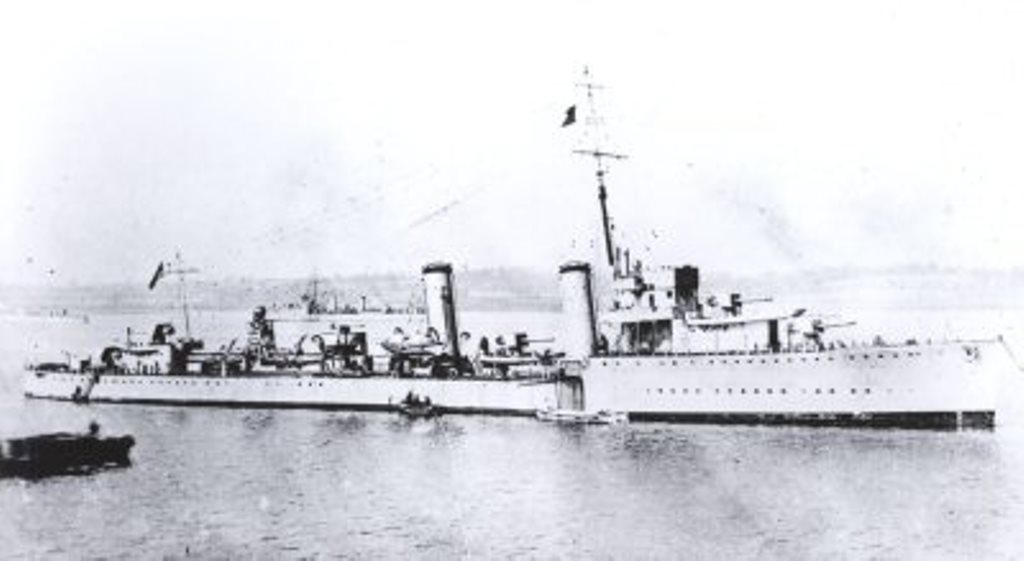
HMS Scott
Type. Destroyer
Class. V&W
Builder. Cammell Laird
Ordered. 1916
Laid Down. 19/12/1917
Launched. 18/10/1917
Speed. 36.5 Knots
Fate. 15/08/1918
HMS Scott was the lead ship of her class of flotilla leaders for the V- and W-class destroyers built during the First World War, and the class would unofficially be named after her. Completed in 1918, the ship was assigned to the Harwich Force and was sunk by either a naval mine or by a German submarine in August while escorting a convoy. The ship herself was the first to bear the name Scott and was named after Sir Walter Scott, 1st Baronet.
Scott was laid down by Cammell Laird at their shipyard in Birkenhead on 19 February 1917, launched on 18 October 1917 and completed on 16 January 1918 at a cost of £342,570, complete with guns and ammunition.
After working up, the ship was assigned to the 10th Destroyer Flotilla in the Harwich Force. While escorting a small convoy from the Netherlands to England on 15 August, the destroyer HMS Ulleswater was struck by either a mine or a torpedo near the Dutch coast. While manoeuvring to assist the stricken ship, Scott was hit twice in quick succession, the first of which detonated her forward magazine. The ship sank about fifteen minutes later with the loss of 22 crewmen.
The cause of her sinking is unclear, although the German submarine U-71 which had been patrolling and mining the area is usually credited with her sinking.
Extract from ‘Counting Ones Blessings. The Selected Letters of Queen Elizabeth The Queen Mother’
Dutch House
Dovercourt
4 o’clock
26 May 1918 to Beryl Poignand
Here is my promised letter. I am still waiting yours! It is great fun here, tho’ we did nothing till yesterday when we dined with Wisp.
My first visit to a warship of any kind at all! We have just come back from lunching & will be shortly returning to dine!!! Well I’ll tell you about it. You see we didn’t go before as he was boiler cleaning. We take the train out of Parkeston and there his motor launch meets us, and we go alongside ‘Scott’*. Then there is a ‘wavy ladder’ [thank the Lord there are ropes each side] and when you get to the top a couple of sailors who salute, and one feels foolish and doesn’t know if one ought to bow low and return their salutation! Then one falls heavily down the hatch [is it?] into the arms of a Sub or [preferably] a Lieut! Wisp’s cabins are most luxurious and Beautifully fitted, as of course it is one of the very newest ships. He has his meals in lonely splendour, the Ward room is opposite. He’s got three pipers & they always play during meals which is very nice. I Haven’t seen over the ship yet, but hope to soon […]
The station master [Syme] at Glamis’ son is still with Wisp. He is a very good-looking man, and excellent I believe, He bursts in at meals with Signals, he is Yeoman of Signals. The Sub also yells things in & says ‘Aye Aye Sir’ & altogether it’s fearfully nautical!!! Mess traps, Hatch somethings, Port holes. Cocktails. Aft-Forrard Etc Etc […]
Very loving Elizabeth
HMS Scott was torpedoed a few months later with the loss of twenty-six men. Wisp Leveson-Gower survived.
HMS Southdown
- Type. Destroyer
- Class. Hunt
- Pennant. L25
- Builder. JS White
- Ordered. 11/04/1939
- Laid Down. 22/08/1939
- Launched. 05/07/1940
- Commissioned. 08/11/1940
- Fate. Scrapped 01/11/1956
HMS Southdown was a type I Hunt Class Escort Destroyer ordered from J S Write, Cowes IoW on 11th April 1939.The ship was laid down on 22nd August 1939 and launched on 5th July 1940.
HMS Southdown was converted for use as an air target ship at Rosyth in September 1945 and carried out that role after her armament had been removed. She was withdrawn from service in April 1946. The ship Paid-off and reduced to Reserve status at Portsmouth during May that year. The ship remained in the Reserve Fleet until 1955 and was placed on the Disposal List. Sold to Bisco for demolition by T W Ward at Barrow in 1956 she arrived at the breaker’s yard in tow on 1st November 1956.
HMS Teazer
- Type. Destroyer
- Class. T
- Pennant. R23
- Builder. Cammell Laird
- Ordered. 13/03/1941
- Laid Down. 20/10/1941
- Launched. 07/01/1943
- Commissioned. 13/09/1943
- Speed. 36 Knots
- Fate. Scrapped 1965
HMS Teazer was a T-class destroyer launched by Cammell Laird on the 7th January 1943. During the month of September 1943; HMS Teazer underwent Builder’s Trials before being commissioned. Upon commissioning, she was accepted into the 24th Destroyer Flotilla. In July of 1944, she was placed under U.S Navy command and was one of the ships scheduled to support the landing in the South of France as part of Operation Dragoon.
In May of 1945, following a refit in January and February, she was assigned to Task Force 57 and then TF37 in the Pacific and was responsible for providing an escort screen to the large Royal Navy carriers used in raids on the Japanese Home Islands.
In 1957.Teazer was used during the making of the film Yangtze Incident. She depicted both HMS Consort and HMS Concord. Some of the most impressive scenes in the film come when this wartime destroyer is seen steaming at speed and firing broadsides in the narrow confines of the River Orwell.
HMS Teazer was scrapped at Dalmuir in August 1965.
HMS Terpischore
- Type. Destroyer
- Class. T
- Pennant. R33, F19
- Builder. William Denny
- Ordered. 13/03/1941
- Laid Down. 25/11/1941
- Launched. 17/06/1943
- Commissioned. 20/01/1944
- Speed. 36 Knots
- Fate. Scrapped 1966
HMS Terpsichore was a T-class destroyer of the British Royal Navy that saw service during World War II. Built by William Denny, Dumbarton and launched on the 17th June 1943. She was later converted to a Type 16 fast anti-submarine frigate; with the new pennant number F19. Terpischore was scrapped at Troon in May 1966.
HMS Tyrian
- Type. Destroyer
- Class. T
- Pennant. R67, F67
- Builder. Swan Hunter
- Ordered. 1941
- Laid Down. 15/10/1941
- Launched. 27/07/1942
- Commissioned. 08/04/1943
- Speed. 36 Knots
- Fate. Scrapped 09/03/1965
HMS Tyrian was a T-class destroyer of the Royal Navy launched by Swan Hunter on the 27th July 1942. She was later converted to a Type 16 fast anti-submarine frigate; with the new pennant number F67. Tyrian returned to UK after a visit to Melbourne with Destroyer Tenacious, Tumult and Undine in February 1946.She was reduced to Reserve status at Harwich after arrival on 30th May 1946, after returning from her service with the Pacific Fleet. 1956 she was initially laid-up at Chatham but transferred to Lisahally, Northern Ireland in 1957. Placed on the Disposal List in 1965 she arrived in tow at the Breaker’s in Troon, Ayrshire for demolition on 9th March 1965.
HMS Valorous
- Type. Destroyer
- Class. V
- Pennant. L00
- Builder. William Denny
- Laid Down. 25/05/1916
- Launched. 08/05/1917
- Commissioned. 21/08/1917
- Speed. 34 Knots
- Fate. Scrapped 04/03/1947
HMS Valorous was a V-class destroyer leader The ship was ordered in April 1916 for delivery in April 1917 and was laid down on 25 May 1916 by William Denny and Brothers of Dumbarton, Scotland. Sometime prior to launching, she was renamed HMS Valorous, and she was launched under that name on 8 May 1917.
When the United Kingdom entered World War II in September 1939, Valorous took up convoy defence duties in the North Sea and North-western Approaches with Rosyth Force. In January 1940 her duties were expanded to include the defence of convoys along the east coast of Great Britain and in the English Channel. She did not take part in the evacuation of Allied troops from Dunkirk, France, remaining on convoy escort duties instead. In July 1940, Valorous duties expanded again to include anti-invasion patrols. In 1941, after the threat of invasion had subsided, she returned to her convoy escort focus. On 21 June 1941 she rescued the only three survivors of the tanker Vancouver, which had struck a naval mine and caught fire off Sunk Head Buoy, Harwich, with the loss of 45 lives while on a voyage from Shell Haven to Halifax, Yorkshire.
Valorous was decommissioned in 1945 – sources differ on whether she had been deleted from the Royal Navy’s active list as of July 1945 or stayed in commission until after the surrender of Japan on 15 August 1945 – and placed on the disposal list in 1946. She was sold on 4 March 1947 for scrapping at Thornaby.
HMS Verdun
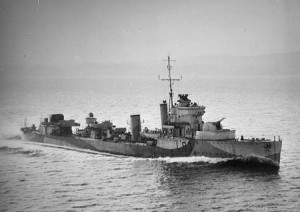
HMS Verdun
- Type. Destroyer
- Class. V
- Pennant. L93
- Builder. Hawthorn Leslie
- Ordered. 1916-17
- Laid Down. 13/01/1917
- Launched. 21/08/1917
- Commissioned. 03/11/1917
- Speed. 34 Knots
- Fate. Scrapped 1946
HMS Verdun was a Admiralty V class destroyer Launched on 21 August 1917 at the Hawthorn Leslie shipyard in Hebburn on Tyneside, she completed in November of the same year. She served with the Grand Fleet and the Harwich Force.
Verdun went into reserve at Rosyth as part of the 9th Destroyer Flotilla until September 1939, when she was selected for conversion into an Anti-Aircraft Escort at Chatham Dockyard. She was rearmed and her pennant number changed from D93 to L93 on completion in May 1940. She operated as a convoy escort out of Rosyth and in the North Sea, being damaged by a bomb on 1 November 1940 that killed 11 men, including her captain. She was repaired at Harwich and spent the rest of the war escorting convoys along the east coast. In November 1941, she was in sustained action against an attack by German E-boats; three British merchant ships were sunk in the engagement. From February to April 1942 she formed part of the escort screen for heavy units of the Home Fleet that were supporting the Arctic convoys. After the “Warship Week” National Savings campaign in March 1942, HMS Verdun was placed in reserve after VE Day and then sold to be scrapped at Granton, Edinburgh in April 1946. Image shows “Verdun” as an Escort Destroyer in WW2.
HMS Vesper
- Type. Destroyer
- Class. V
- Pennant. D55
- Builder. Alexander Stephens
- Ordered. 30/06/1916
- Laid Down. 07/12/1916
- Launched. 15/12/1917
- Commissioned. 1939
- Speed. 34 Knots
- Fate. Scrapped 1948
HMS Vesper was an Admiralty V class Destroyer. She was laid down on 7 December 1916 by Stephen’s of Govan, Glasgow, and launched on 15 December 1917. She was completed on 20 February 1918.
Vesper was recommissioned in 1939. After the United Kingdom entered World War II in September 1939, she was assigned to convoy defence and patrol duties in the South-western Approaches through December 1939. From January through April 1940, she performed similar duties in the English Channel and North Sea. On 14 February 1940 she and the destroyer HMS Whitshed rescued 72 survivors of the British merchant ship Sultan Star, which the German submarine U-77 had sunk southwest of the Scilly Isles.
After Germany‘s surrender, Vesper did not deploy operationally, and she soon was decommissioned and placed in reserve, being no longer included on the Royal Navy’s July 1945 active list. She was sold to Bisco on 7 March 1947 for scrapping by T. W. Ward, and arrived at the shipbreakers yard in March 1948.
HMS Walker
- Type. Destroyer
- Class. W
- Pennant. G22, G09, D27, I27
- Builder. William Denny
- Speed. 34 knots
- Laid Down. 26/03/1917
- Launched. 22/01/1913
- Commissioned. 1915
- Speed. 34 Knots
- Fate. Scrapped 22/07/1937
HMS Walker was a W-class destroyer of the British Royal Navy that saw service in the final months of World War I, World War II.Walker was ordered on 9 December 1916; she was laid down by William Denny and Brothers at Dumbarton, Scotland, on 26 March 1917. She was launched on 29 November, completed on 12 February 1918.
During May 1940, Walker’s pennant number was changed to I27. On 28 May, she and the destroyers HMS Beagle, HMS Fame , and HMS Havelock deployed in Norway’s Rombaksfjord to provide gunfire support during an Allied ground operation to capture Narvik. As the Norwegian Campaign ended in an Allied failure to halt the German conquest of that country, Walker became the last Allied ship to leave the Narvik area as she escorted the final Allied evacuation convoy from Norway, departing Harstad on 8 June 1940.
In January 1944, Walker was transferred to the Home Fleet to escort Arctic convoys to and from the Soviet Union. In February 1944, she was part of the close escort group for Convoy JW 57 during its voyage from the United Kingdom to the Soviet Union along with Keppel, the destroyers HMS Beagle and HMS Boadicea and four Flower-class corvettes; although the convoy endured German air and submarine attacks during its passage, it suffered no losses among its convoyed ships and arrived at the Kola Inlet on 28 February 1944. On 2 March, the ship joined the same vessels as close escort for the returning Convoy RA 57, which came under attack by German submarines on 4 March and arrived at Loch Ewe, Scotland, on 10 March 1944.
Walker did not deploy operationally after Germany’s capitulation; the Royal Navy soon decommissioned her and placed her in reserve. She was sold on 15 March 1946 for scrap and was disposed of at Troon in Scotland.
HMS Walpole
- Type. Destroyer
- Class. W
- Pennant. D41
- Builder. William Doxford
- Ordered.
- Laid Down. 1917
- Launched. 12/02/1918
- Commissioned. 07/08/1918
- Speed. 34 Knots
- Fate. Scrapped 08/05/1945
HMS Walpole was a W-class destroyer of the Royal Navy built under the 1916-17 Programme in the 10th Destroyer order. Walpole was assigned to the 13th Destroyer Flotilla in the Grand Fleet after completion, and served until almost the end of the Second World War. Her role was mostly convoy escort duties, but she took part in two combined arms operations (Operations Amsterdam and Jubilee) and the D-day landings (Operation Neptune). She hit a mine on 6 January 1945 and was subsequently declared a Constructive Total Loss and broken up in Grays, Essex in March 1945.
HMS Whitshed
- Type. Destroyer
- Class. W
- Pennant. D77
- Builder. Swan Hunter
- Ordered. 1918
- Laid Down. 03/06/1918
- Launched. 31/01/1919
- Commissioned. 11/06/1919
- Speed. 34 Knots
- Fate. Scrapped 1948
HMS Whitshed was an Admiralty modified W-class destroyer of the Royal Navy. She was ordered from Swan Hunter & Wigham Richardson Ltd She was launched on 31 January 1919. On 31st July 1939 she sustained serious structural damage after detonating a mine off Harwich. Wild Swan towed her back to Harwich. She was under repair until December.
In February 1942, Whitshed joined the destroyers MacKay and Walpole of the 21st Flotilla and Campbell, Worcester and Vivacious of the 16th Flotilla. On the 12th, she carried out a torpedo attack on the German battleships Scharnhorst and Gneisenau and heavy cruiser Prinz Eugen, which had broken out of Brest and proceeded via the Dover Straits to Wilhelmshaven in the Channel Dash.For the remainder of 1942 and most of 1943, Whitshed undertook convoy escort duties and patrolled the North Sea and English Channel. In 1942, her ‘A’ gun was replaced with a twin 6-pounder army gun for engaging E-Boats. In November 1943 she was in action with E-Boats while escorting convoy CW221 off Hastings with two motor gun boats and four motor launches of the Coastal Forces. On 18 April 1944 she was in action again with E-Boats on a mine laying operation in the English Channel.
In June 1944 she joined Escort Group 104 with HMS Montrose, HMS Borage and HMS Loosestrife and escorted convoy EIL1 comprising 12 Landing Ship Tank (LST) and 24 Landing Craft Tank from Southend to the assembly area of the Eastern Task Force. Then she returned to Southend to escort the build-up convoys.
In July she was released from Operation Neptune and resumed mercantile convoy escort and interception patrols engaging E-Boats and submersibles employed in mine laying operations in the North Sea and English Channel through April 1945. After VE-Day she was deployed in re-occupation operations. In June 1945 she was reduced to reserve status.
HMS Whitshed was not deployed again operationally and after the end of hostilities she was paid off and reduced to reserve status. The ship was placed on the Disposal List in 1946. She was sold to BISCO in February 1947 for demolition by TJ King. The ship arrived at the breakers yard at Gateshead in April 1948.
HMS Wild Swan
- Type. Destroyer
- Class. W
- Pennant. D62
- Builder. Swan Hunter
- Ordered. 1918
- Laid Down. 1918
- Launched. 17/05/1919
- Commissioned. 14/11/1919
- Speed. 32 Knots
- Fate. Sunk 17/06/1942
HMS Wild Swan was a W Class Destroyer built by Swan Hunter and Wigham Richardson, Wallsend-on-Tyne and launched on the 17th of May 1919. Upon completion she was nominated to join the 18th Destroyer Flotilla; however, she was diverted to Plymouth to carry out trials on degaussing equipment. Having been detached from a convoy, Wild Swan was steaming in the Western Approaches, when she came under heavy air attack from a squadron of German Junkers Ju 88 bombers. The bombers had been dispatched to attack the convoy, but as Wild Swan happened at the time to be steaming through a formation of Spanish trawlers, the German aircraft misidentified these small vessels as the convoy and started to attack. The British reported that three of the trawlers were sunk by bombs. Wild Swan replied with vigour, the ship’s crew claiming six German aircraft destroyed, the record for any single ship in the war. But the naval vessel was already damaged by near-misses and she had lost steering control. The destroyer eventually collided with one of the Spanish trawlers, which sank almost immediately. After picking up 11 survivors from the trawler, Wild Swan also sank, her bows and stern rising up into a “V” shape before she slipped under the surface.
HMS Wilton
- Type. Escort Destroyer
- Class. Hunt
- Pennant. L128
- Builder. Yarrow Shipbuilder
- Ordered. 04/09/1939
- Laid Down. 07/07/1940
- Launched. 17/10/1941
- Commissioned. 18/02/1942
- Speed. 27 Knots
- Fate. Scrapped 30/11/1959
HMS Wilton was a Hunt Class Escort Destroyer ordered from Yarrow’s at Scotstoun. Glasgow on 4th September 1939 in the 1939 War Emergency Programme and laid down as Job No J1850 on 7th June 1940. She was launched on 17th October 1941.
HMS Wilton completed refit in January 1946 and returned to UK to Pay-off and reduce to Reserve at Plymouth in February 1946. The ship remained in the Reserve Fleet at Plymouth until 1949 when she re- commissioned for service in the 4th Training Flotilla. Later this destroyer was disarmed and used as an Air Target ship. She was again placed in Reserve and laid up at Cardiff in 1953 for five years. Placed on the Disposal List in 1959 the ship was sold to Shipbreaking Industries for demolition at Faslane. She arrived at the breaker’s yard in the Clyde on 4th December 1959.
8 August 1948 under tow from Plymouth to Harwich.
HMS Windsor
- Type. Destroyer
- Class. W
- Pennant. F12, D42
- Builder. Scott’s
- Ordered. 09/12/1916
- Laid Down. 1917
- Launched. 21/06/1918
- Commissioned. 28/08/1918
- Fate. Scrapped 04/03/1947
HMS Windsor was assigned to the 18th Destroyer Flotilla at Portland, England, for convoy escort and patrol duty in the English Channel and South-western Approaches. In October 1939 she transferred to Western Approaches Command but continued her assignment in the South-western Approaches. By January 1940, she was based at Plymouth for these duties.
Windsor returned to the 16th Destroyer Flotilla at Harwich in July 1941 and resumed her North Sea convoy and patrol duties. By January 1942, these duties had begun to include operations to intercept German motor torpedo boats – S-boats, known to the Allies as “E-boats” – in the North Sea before they could mount attacks against Allied ships. On 13 March 1942, she, Walpole, and the escort destroyers HMS Blencathra , HMS Calpe , and HMS Fernie deployed in the English Channel to intercept the German merchant raider Michel during Michel’s voyage – under escort by five torpedo boats and nine minesweepers – from Flushing in the Netherlands to German-occupied France; Windsor exchanged gunfire with the German ships on 14 March and made a torpedo attack against them, sustaining superficial damage from the German gunfire. She then returned to convoy and patrol duty in the North Sea and English Channel.
During the summer of 1945, Windsor was decommissioned, transferred to the Reserve Fleet, and placed in reserve, no longer being listed on the Royal Navy’s active list by July 1945. After the surrender of Japan on 15 August 1945, Windsor was placed on the disposal list. She was sold on 4 March 1947 to Metal Industries for scrapping, arrived under tow at the Shipbreakers yard in Charlestown, Fife, Scotland, in May 1949, and was scrapped in June 1949.
HMS Wivern
- Type. Destroyer
- Class. W
- Pennant. D66
- Builder. JS White
- Ordered. 1918
- Laid Down. 19/08/1918
- Launched. 16/04/1919
- Commissioned. 23/12/1919
- Speed. 34 Knots
- Fate. Scrapped 1948
HMS Wivern was ordered in April 1918 as part of the 13th Order of the 1917-1918 Naval Programme. She was laid down on 19 August 1918 by J. Samuel White at Cowes, Isle of Wight, and launched on 16 April 1919.
In October 1939, Wivern was transferred to the 16th Destroyer Flotilla in Nore Command at Harwich for convoy escort and patrol duty in the North Sea. After the destroyer HMS Gipsy detonated a magnetic mine off Harwich and sank on the evening of 21 November 1939, Wivern steamed through the area at high speed on 22 November in an attempt to detonate any other mines in the area and clear the area for ship traffic.
Wivern continued her North Sea operations without further major incident through the end of 1939 and into 1940.
With her repairs and refit finally complete, Wivern underwent post-refit acceptance trials in September 1944 and recommissioned that month for assignment to Nore Command for service with the Harwich Escort Force. In October 1944, she took up her duties at Harwich, which were focused on nightly patrols to counter the operations of German motor torpedo boats – S-boats, known to the Allies as “E-boats” – in the North Sea. In November 1944, she began escort duty for North Sea convoys during their voyages between the Thames Estuary and Rosyth.
Wivern continued her convoy escort duties in the North Sea until the surrender of Germany in early May 1945. She then deployed to support Allied reoccupation forces in Norway and to transport Allied personnel.
Wivern was decommissioned and laid up at Rosyth later in the summer of 1945, and by October 1945 she no longer appeared on the Royal Navy ’s active list. Later placed on the disposal list, she was sold to Metal Industries on 18 February 1947 for scrapping. She was towed to the breaker’s yard at Charlestown, Fife, Scotland, in October 1948.
HMS Worcester
- Type. Destroyer
- Class. W
- Pennant. D96
- Builder. JS White
- Ordered. 1918
- Laid Down. 20/12/1918
- Launched. 24/10/1919
- Commissioned. 1945
- Speed. 34 Knots
- Fate. Scrapped 17/09/1946
HMS Worcester was ordered in April 1918 as part of the 13th Order of the 1917-1918 Naval Programme. She was laid down on 20 December 1918 by J. Samuel White at Cowes, Isle of Wight, and launched on 24 October 1919. After launching, she was transferred to the Royal Navy Dockyard at Portsmouth for fitting out, and was completed there on 20 September 1922.
In January 1941, Worcester transferred back to the 16th Destroyer Flotilla at Harwich for more North Sea convoy escort and patrol work, this time with Whitshed and the destroyer leader HMS Mackay and destroyer HMS Walpole. In March 1941, she and Whitshed escorted Convoy FS 29, which was steaming south along the east coast of Great Britain and came under German air attack on 6 March. On 7 March, she and Whitshed chased a German motor torpedo boat – an S-boat, known to the Allies as an “E-boat” – which had been detected near the convoy; the two destroyers were unable to make contact with it. Unfortunately for the convoy, the E-boat had been serving as a decoy for the German 1st Torpedo Boat Flotilla, which attacked the convoy when Worcester and Whitshed were too far away to intervene. The Germans penetrated the remaining escort – reduced to only the escort destroyer HMS Pytchley and the patrol vessel HMS Puffin – to sink two of FS 29’s merchant ships.
In May 1944, Worcester was selected for use as an accommodation ship at London upon completion of repairs and modification for her new role. In January 1945 she was towed to London, and after local preparation for use as an accommodation ship, was recommissioned with the new name HMS Yeoman, the second Royal Navy ship of the name, in June 1945. She remained in service as such after the surrender of Japan brought World War II to an end in August 1945.
Yeoman remained in use as an accommodation ship until placed on the disposal list in 1946. She was sold for scrapping on 17 September 1946 to the British Iron and Steel Corporation , which allocated her to Thomas W. Ward to be broken up. She was towed to the Shipbreakers yard at Grays, Essex, England, in February 1947.
HMS Wren
- Type. Destroyer
- Class. W
- Pennant. D88, I88
- Builder. Yarrow
- Ordered. 1918
- Laid Down. 1918
- Launched. 11/11/1919
- Commissioned. 23/01/1923
- Speed. 34 Knots
- Fate. Sunk 27/07/1940
HMS Wren was an Admiralty modified W class destroyer built for the Royal Navy. She was ordered in April 1918 from Yarrow Shipbuilders Limited under the 13th Order for Destroyers of the Emergency War Program of 1918-19. HMS Wren’s keel was laid in June 1918 at the Yarrow Shipbuilders Limited, Scotstoun. The signing of the armistice with Germany led to the cancellation of 35 destroyers out of Wren’s class of 56, but she survived this and the cancellation of a further seven vessels in September 1919. Wren was launched on 11 November 1919 after which she was towed to the dockyard at Pembroke Dock for completion.
In September 1939 Wren was transferred to the 16th Destroyer Flotilla at Portsmouth for convoy defence and anti-submarine patrols in the English Channel and South-West Approaches. In November she was transferred to Nore Command for convoy defence in the North Sea. Wren was re-assigned to the 18th Destroyer Flotilla, Western Approaches Command in January 1940 and undertook convoy defence once more in the South-West Approaches. Following the German invasion of Norway in April 1940 she transferred to Scapa Floe to carry out convoy escort duties to Norway. She provided gunfire support to the British landings at Bjerkvik but returned to convoy duties and did not take part in the evacuation of the British expeditionary force. At the end of May her pennant number was changed to I88 for visual signalling purposes. On 25 June she returned to the 16th Destroyer Flotilla based at Harwich for convoy escort and patrol duties in Nore Command.
On the 27 July 1940 Wren, alongside HMS Montrose, was providing anti-aircraft protection for minesweeping operations off Aldeburgh, Suffolk. She came under heavy and sustained dive bombing attack by 15 Junkers Ju-87 aircraft and was damaged by several near misses which holed her below the waterline. Collapsed bulkheads caused heavy flooding which led her to sink quickly, killing 37 of her crew.
HMS Zenith
- Type. Destroyer
- Class. Z
- Pennant. D95
- Builder. Denny
- Ordered. 12/02/1942
- Laid Down. 18/05/1942
- Launched. 05/06/1944
- Commissioned. 22/12/1944
- Fate. Sold 1955
HMS Zenith was a Z-Class Fleet Destroyer ordered from Denny of Dumbarton on 12th February 1942 with the 10th Emergency Flotilla and to be named Wessex. She was laid down on 19th May 1942 but in 1943, before launch the name was changed to Zenith. The ship was launched on 5th June 1944.
HMS Zenith served with the 4th Flotilla in Home waters on return to UK. In 1947 the ship was Paid-off and was placed in Reserve at Chatham. During 1950 she refitted in a Tyne shipyard and on completion the next year went back into Reserve at Harwich. She was placed on the Sales List and sold to Egypt in May 1955. After refit at Woolston by Thornycroft the destroyer was renamed EL Fateh and sailed to Egypt in September 1956. During 1963 EL Fateh returned to UK for modernisation at Woolston which was completed in July 1964. She remained in Egyptian service for another 15 years before being withdrawn from service.
We are adding more information to this site on a regular basis, if you wish to submit any photos or provide any information on naval vessels that were based or visited Harwich, then please use the contact page at the bottom of the screen.
Copyright Ownership.
We attempted to get the consent of copyright holders to use this material for nearly all of the photographs on the website.
In the few cases where names are available, a thorough search was made using telephone directories, photographic copyright directories, People Search and Google Area Search. None of the copyright owners could be traced in this way and we believe we have exhausted all reasonable avenues.
The consensus opinion of these authorities was that if any two of the following situations applied we would be deemed to have taken sufficient action to avoid infringing copyright laws:
- Reasonable efforts made to contact the copyright holder
- No financial gain will be made in relation to the photos
- A letter is obtained from present owner of photos
- There is a proviso included stating that if offence is caused document will be removed
The website owner undertakes to remove any photograph from the website where offence is caused. All the above conditions have therefore been met.
References.
Friedman, N., 2009. British Destroyers. Naval Institute Press, Annapolis.
Le Fleming, H.M., 1961. Warships of World War 1. Ian Allan, London.
Lenton, H.T. & Colledge, J.J., 1964. Warships of World War II. Ian Allan, London.
J.C Taylor, 1966. German warships of World War II. Ian Allan, London.
With special thanks to. Dr J.R. Laurie, Editor-in-chief, Memoirs of the Association of Australasian Palaeontologists.
Over 70,000 servicemen and more than 1,500 ships had been lost during the two World Wars, with these figures showing that while it may be ‘a sweet and honourable thing to die for your country’, it can also be a costly proposition.
The Commonwealth War Graves Commission ensures that 1.7 million people who died in the two world wars will never be forgotten.
← Minesweepers & Trawlers – World War 1 Destroyers – World War 1 →
